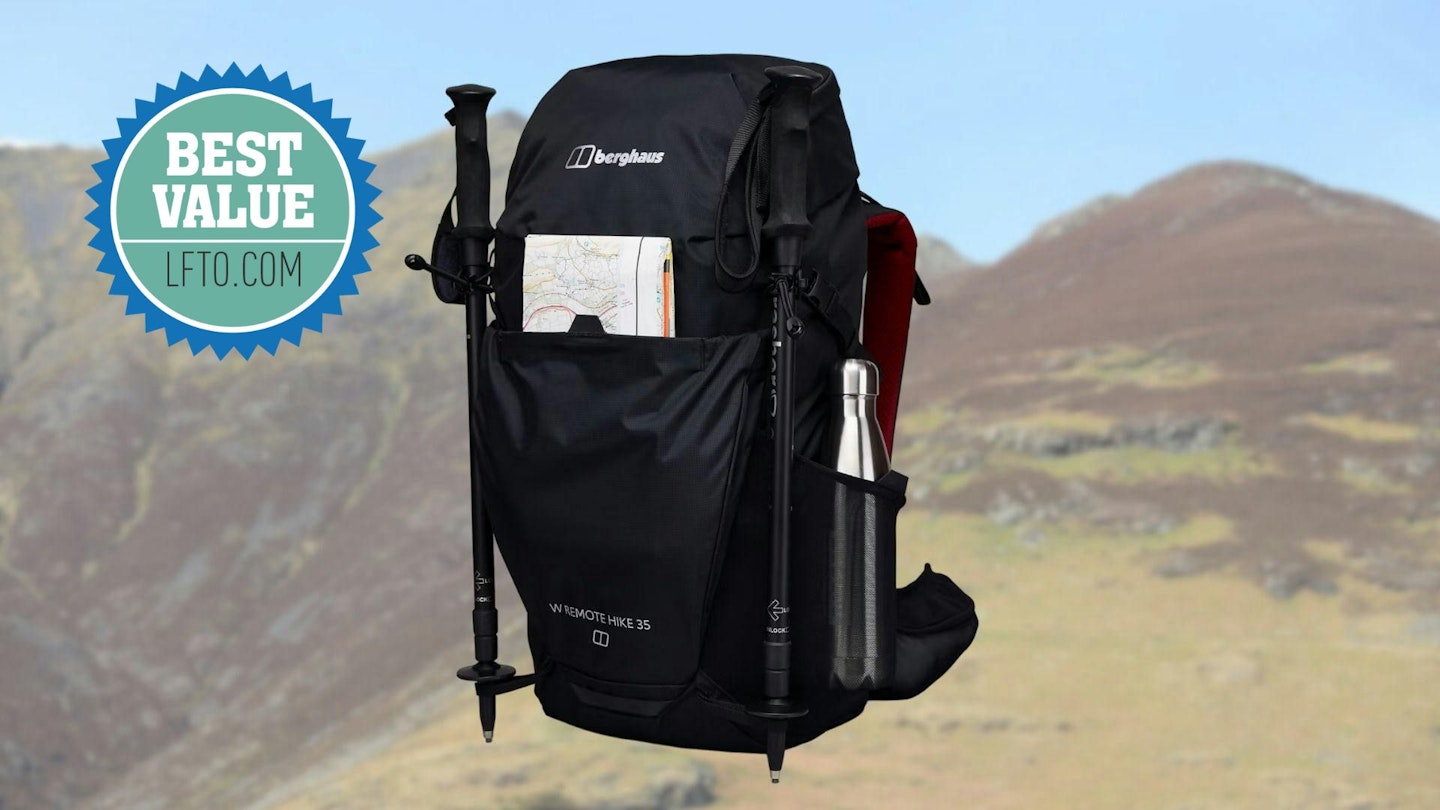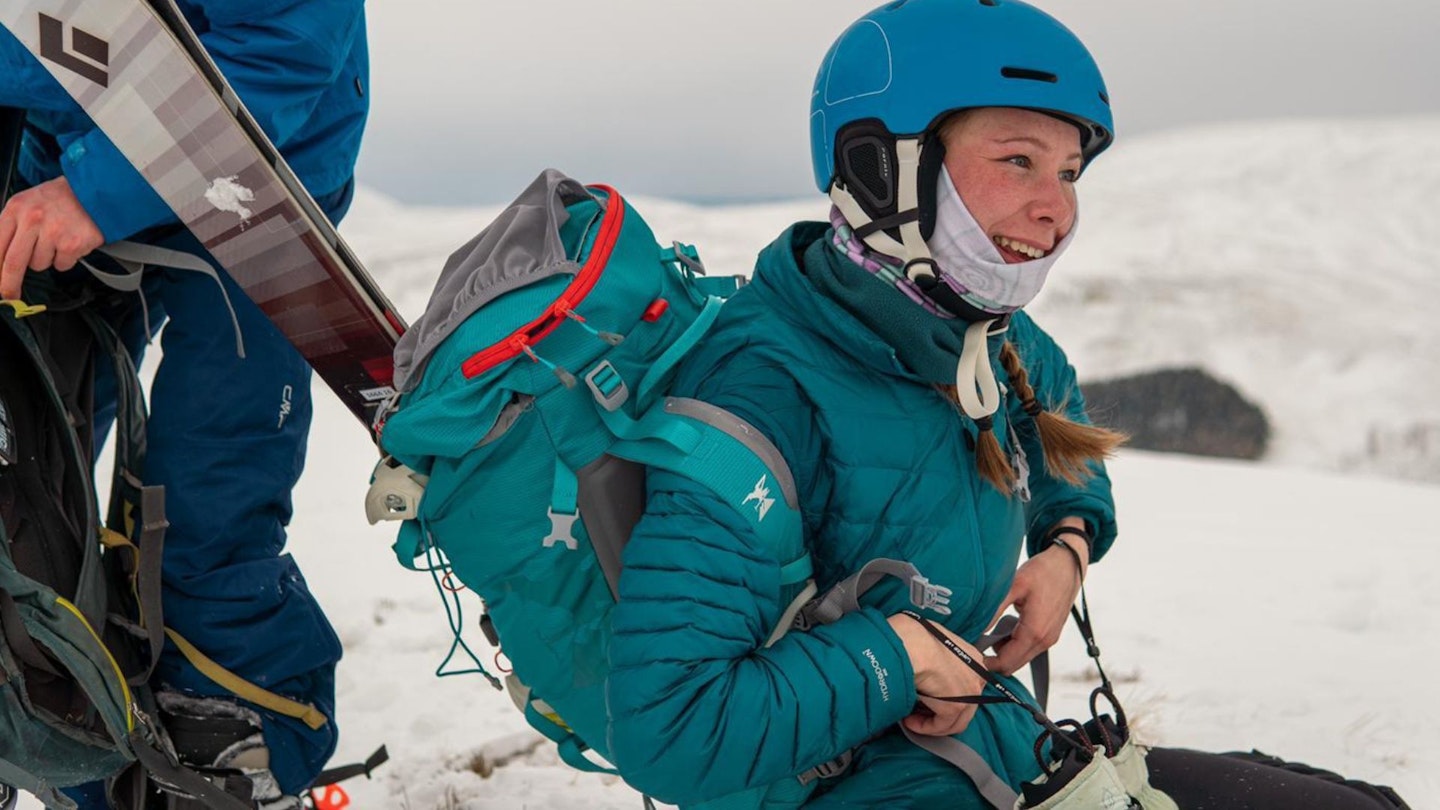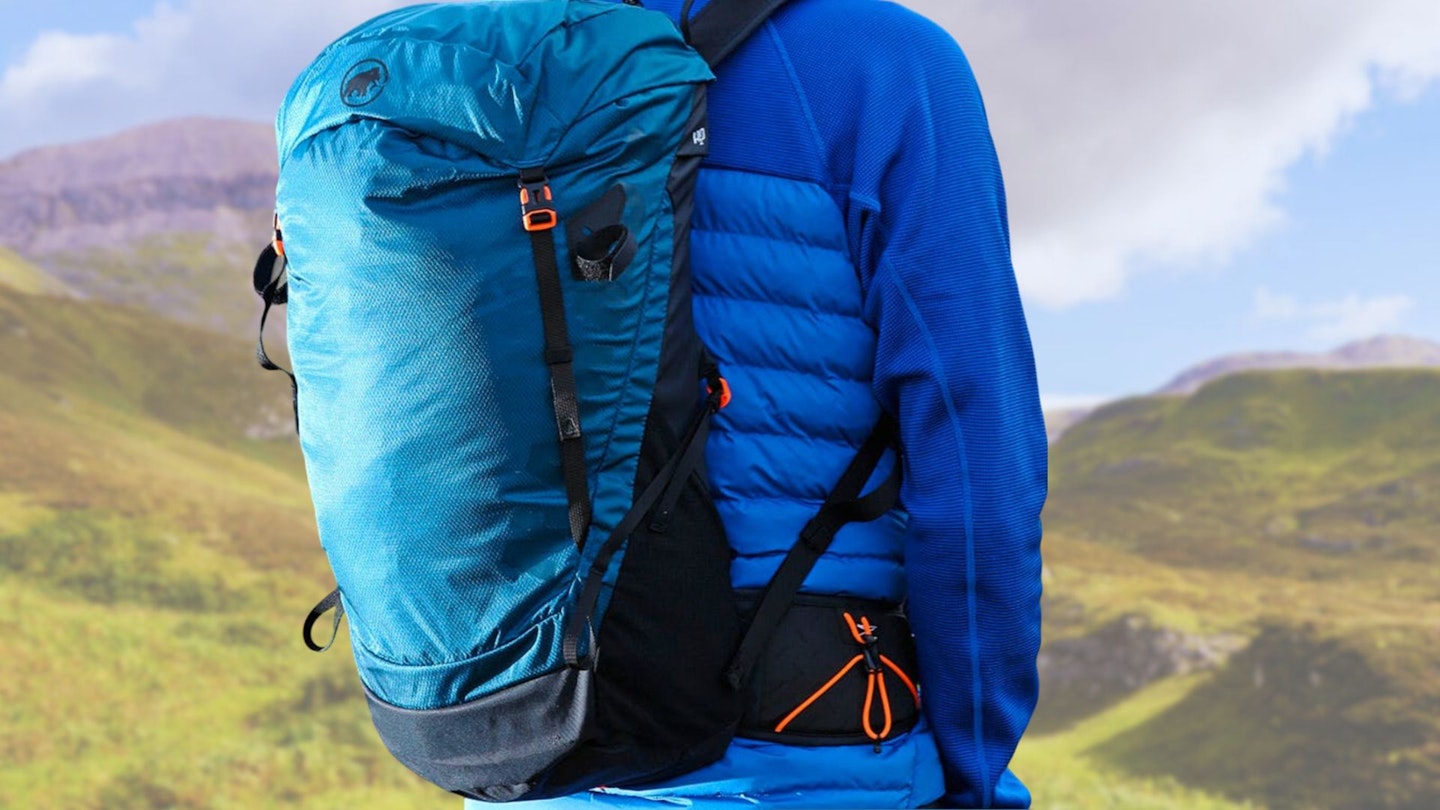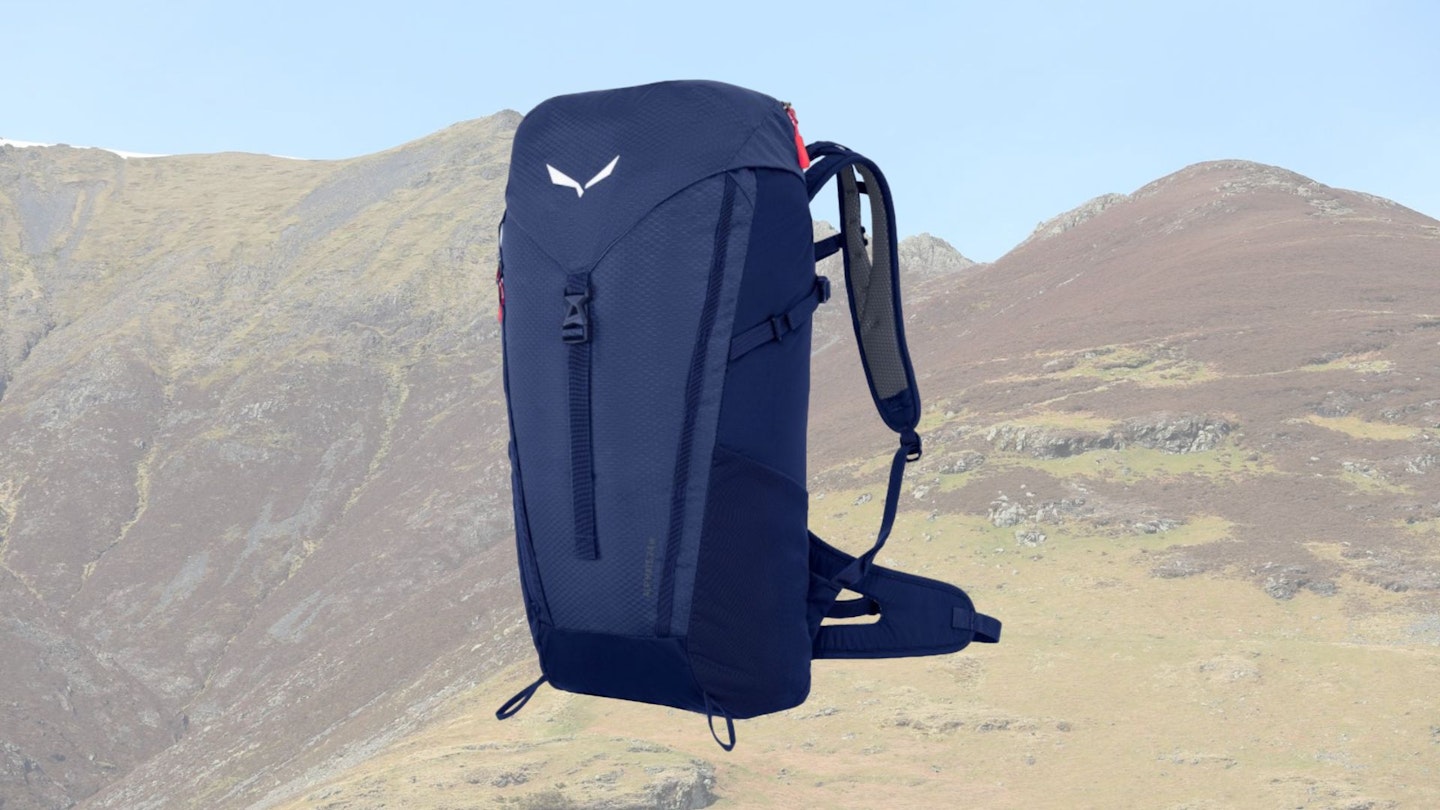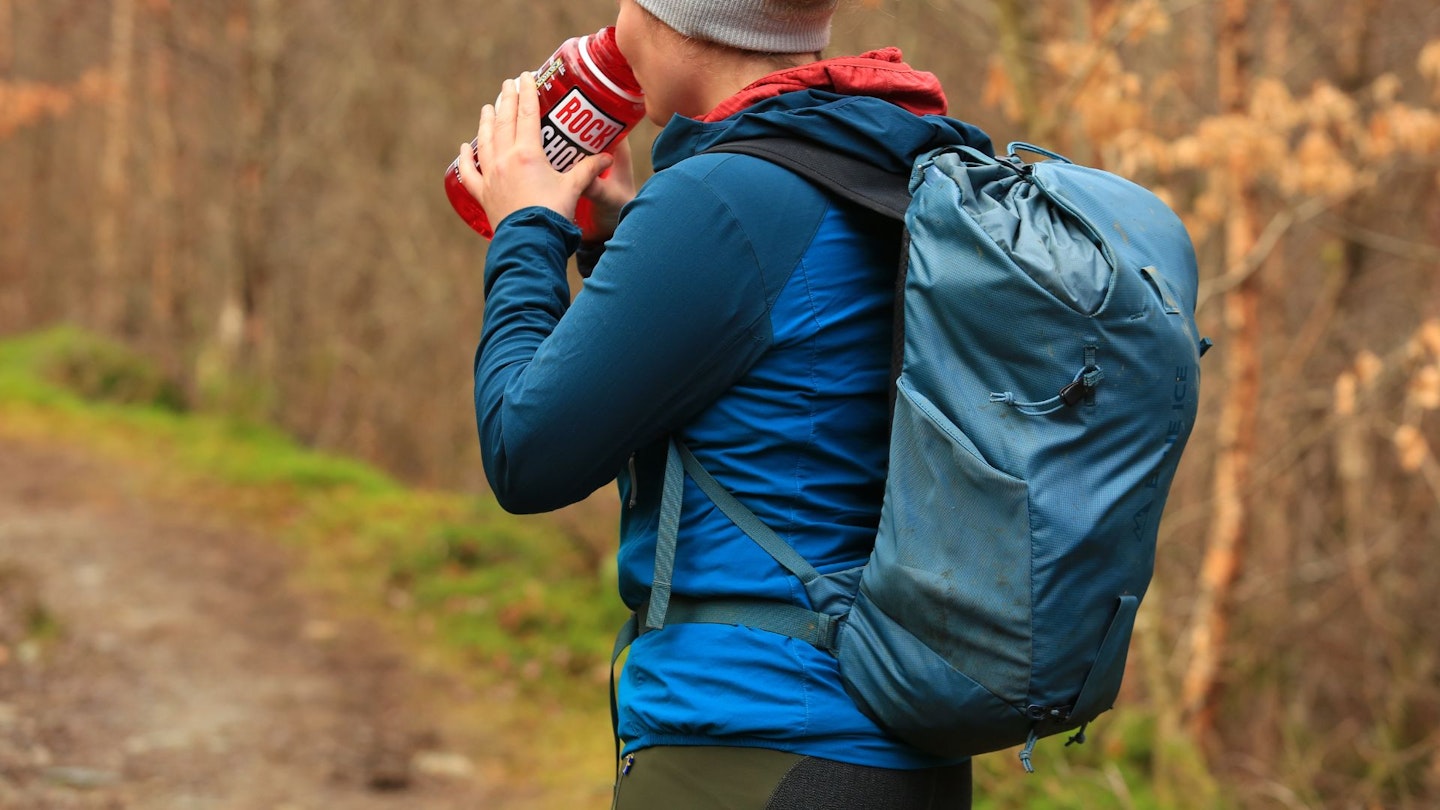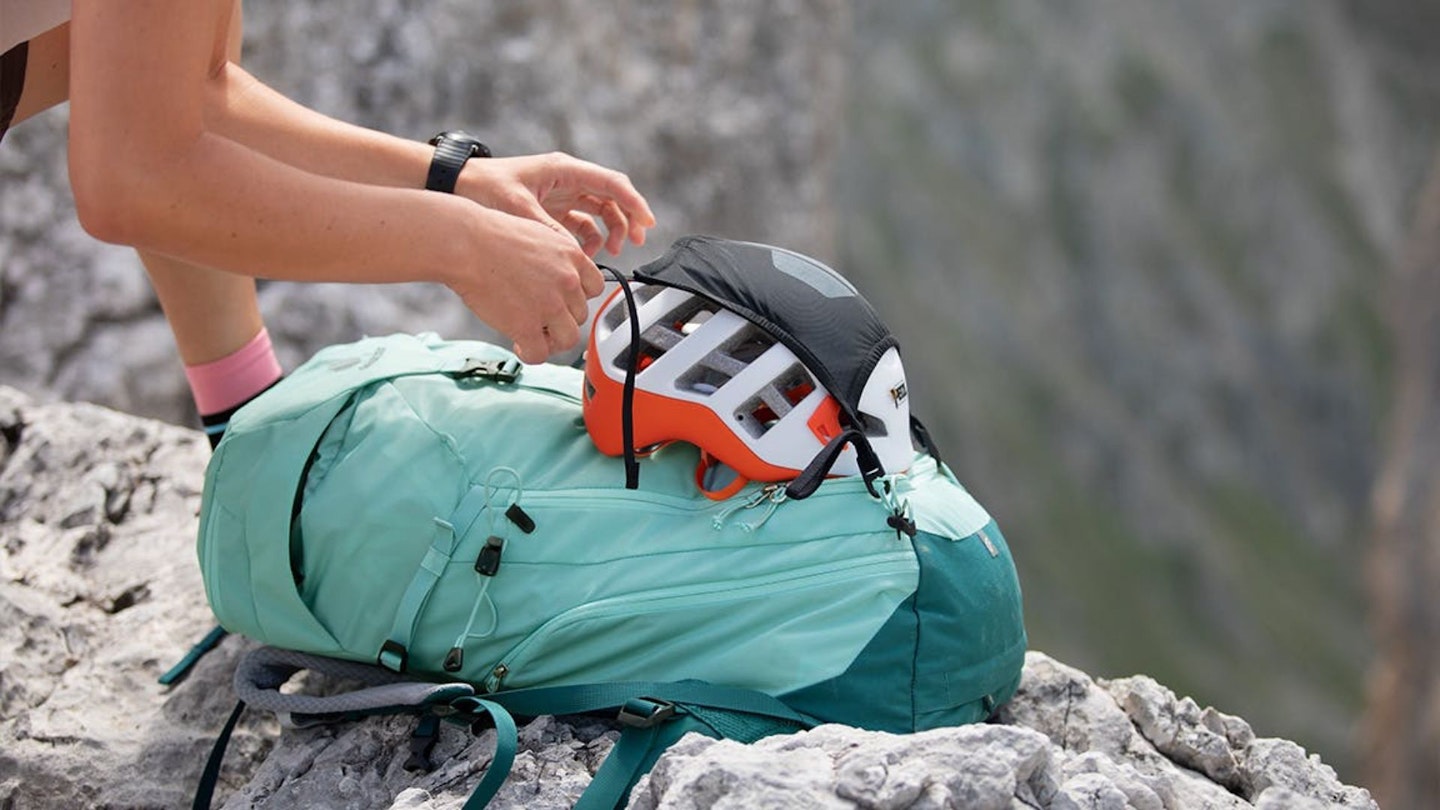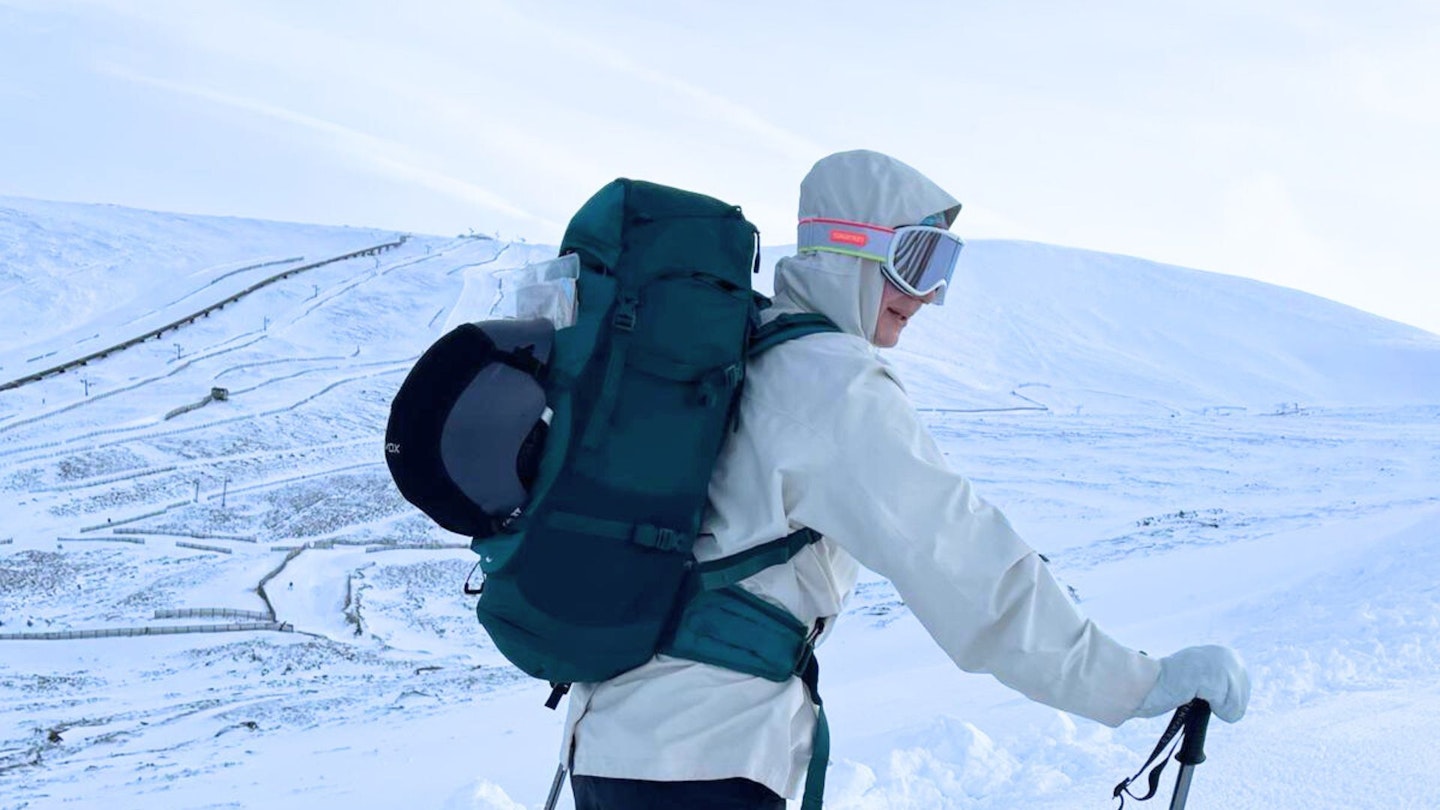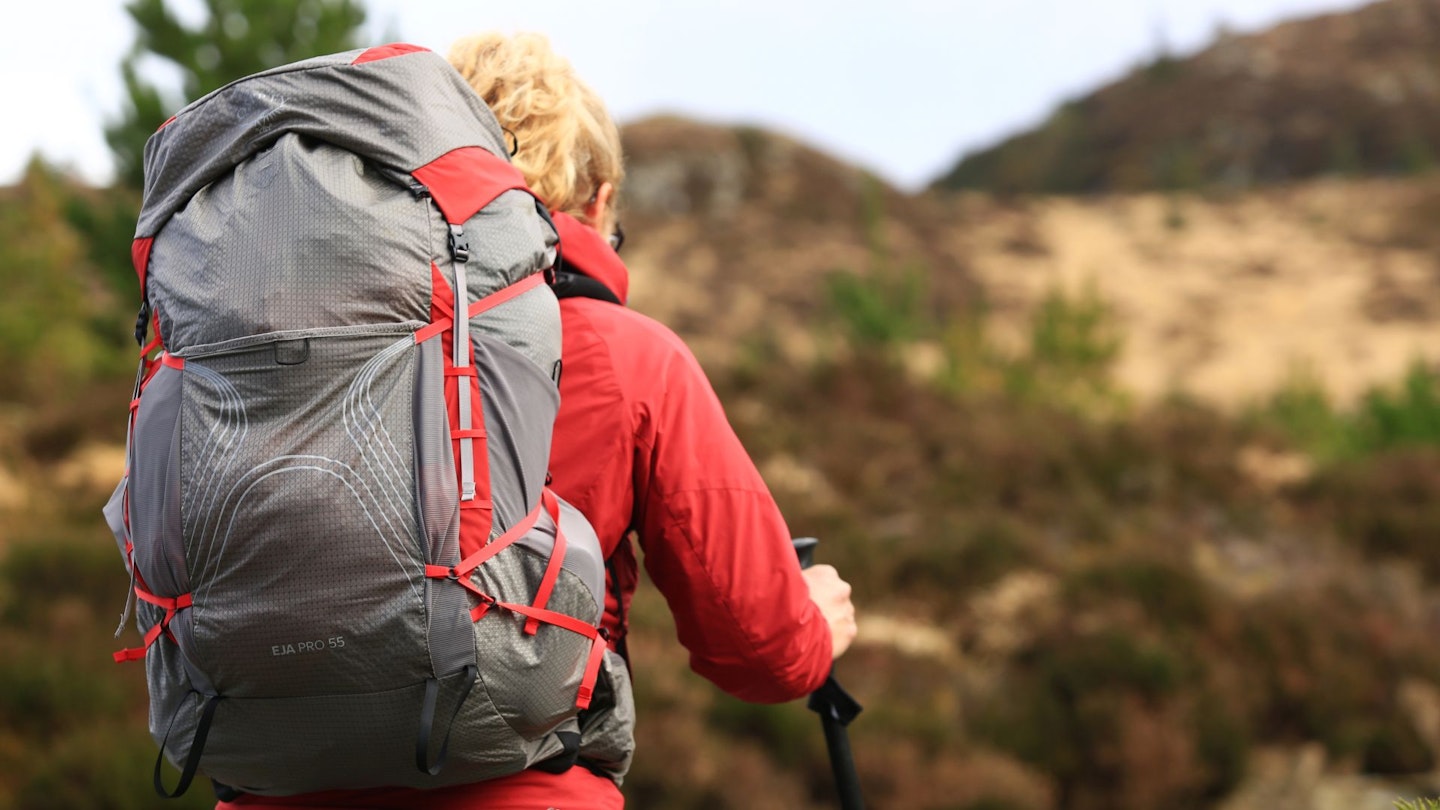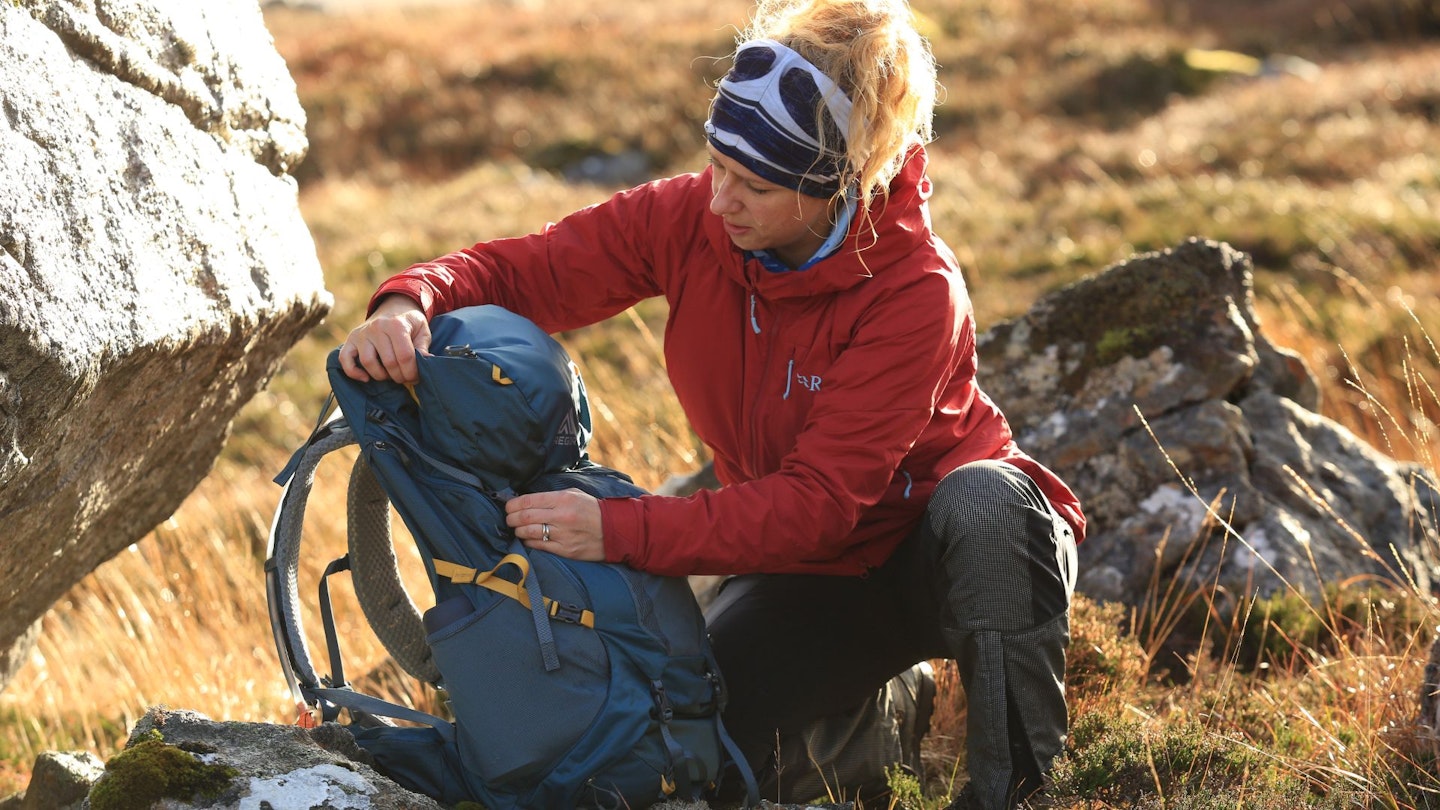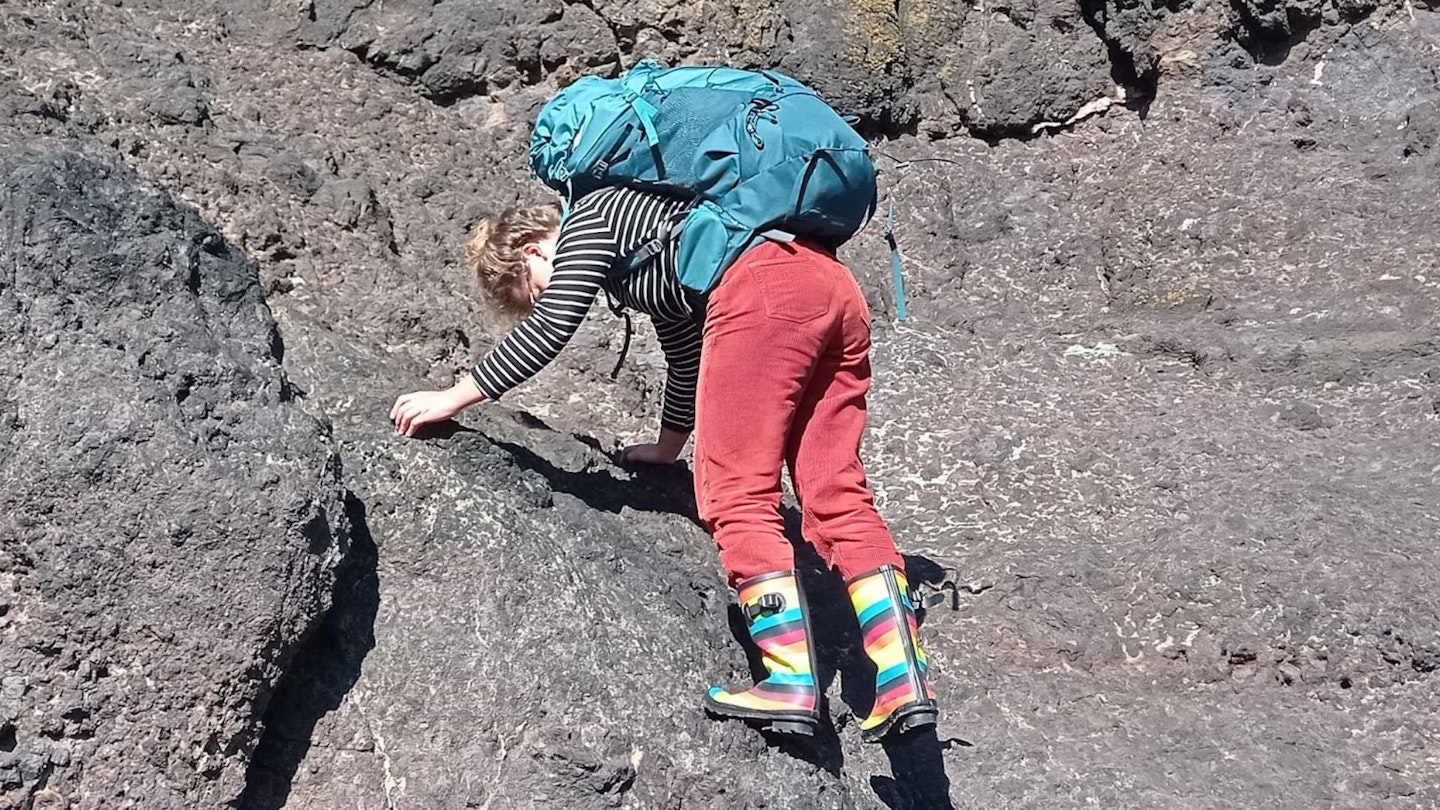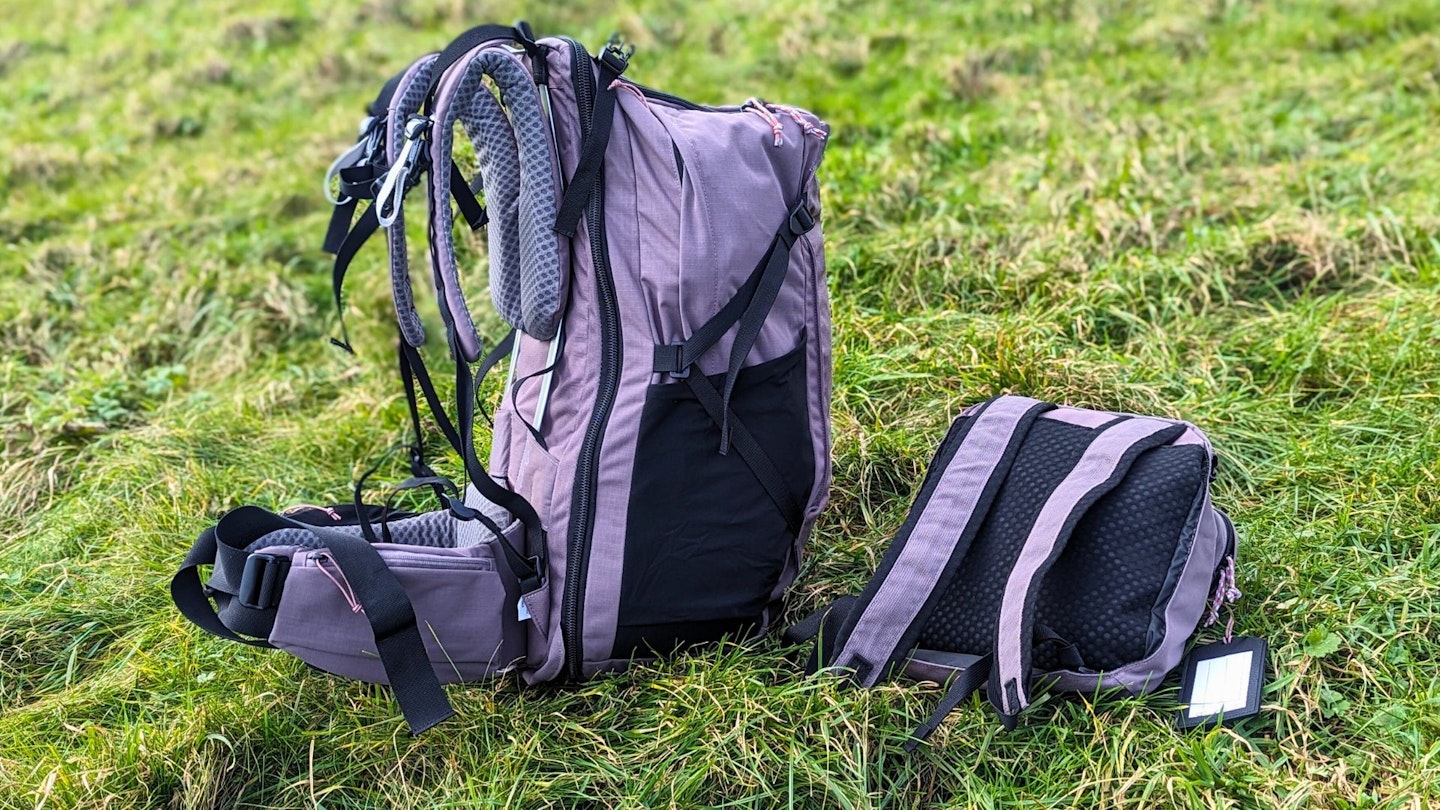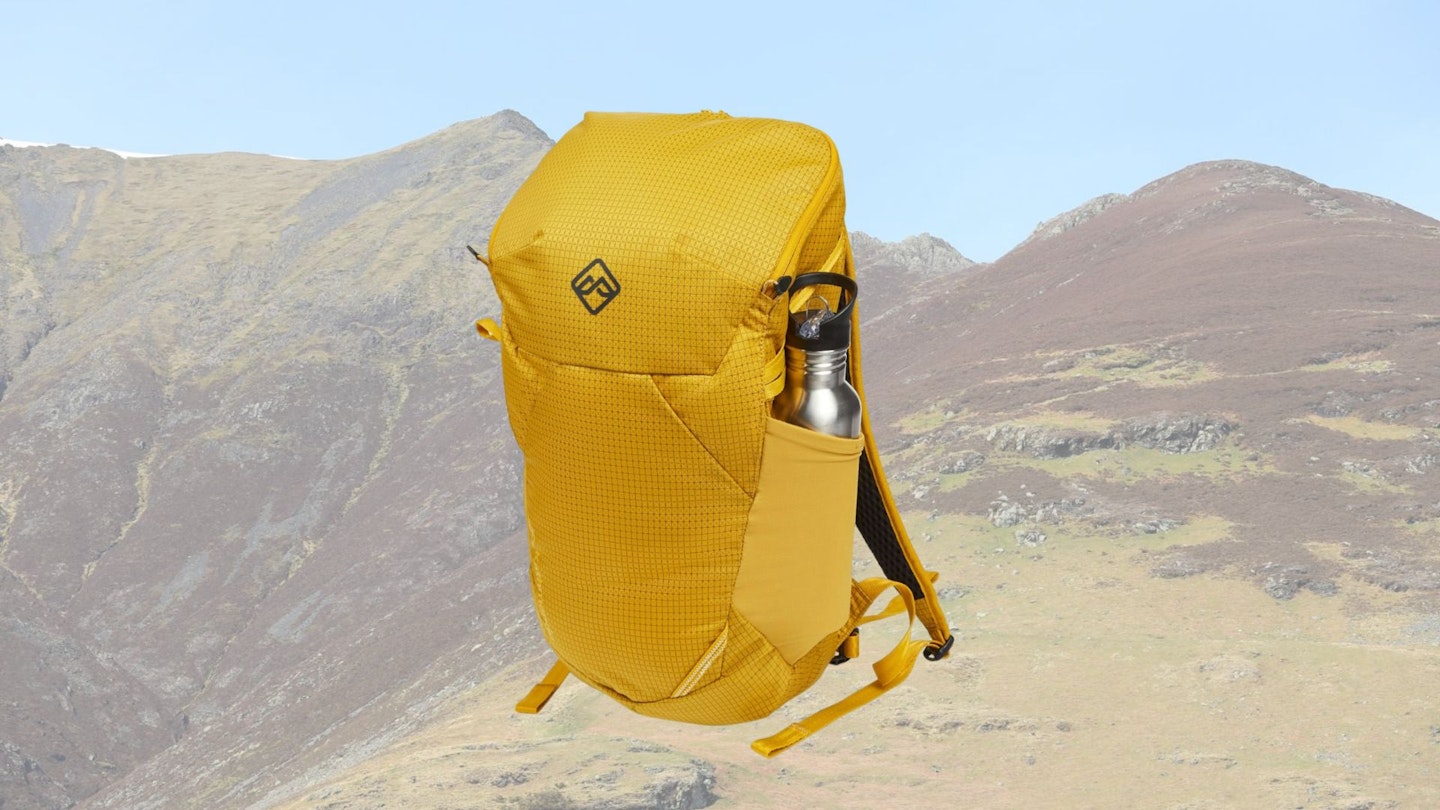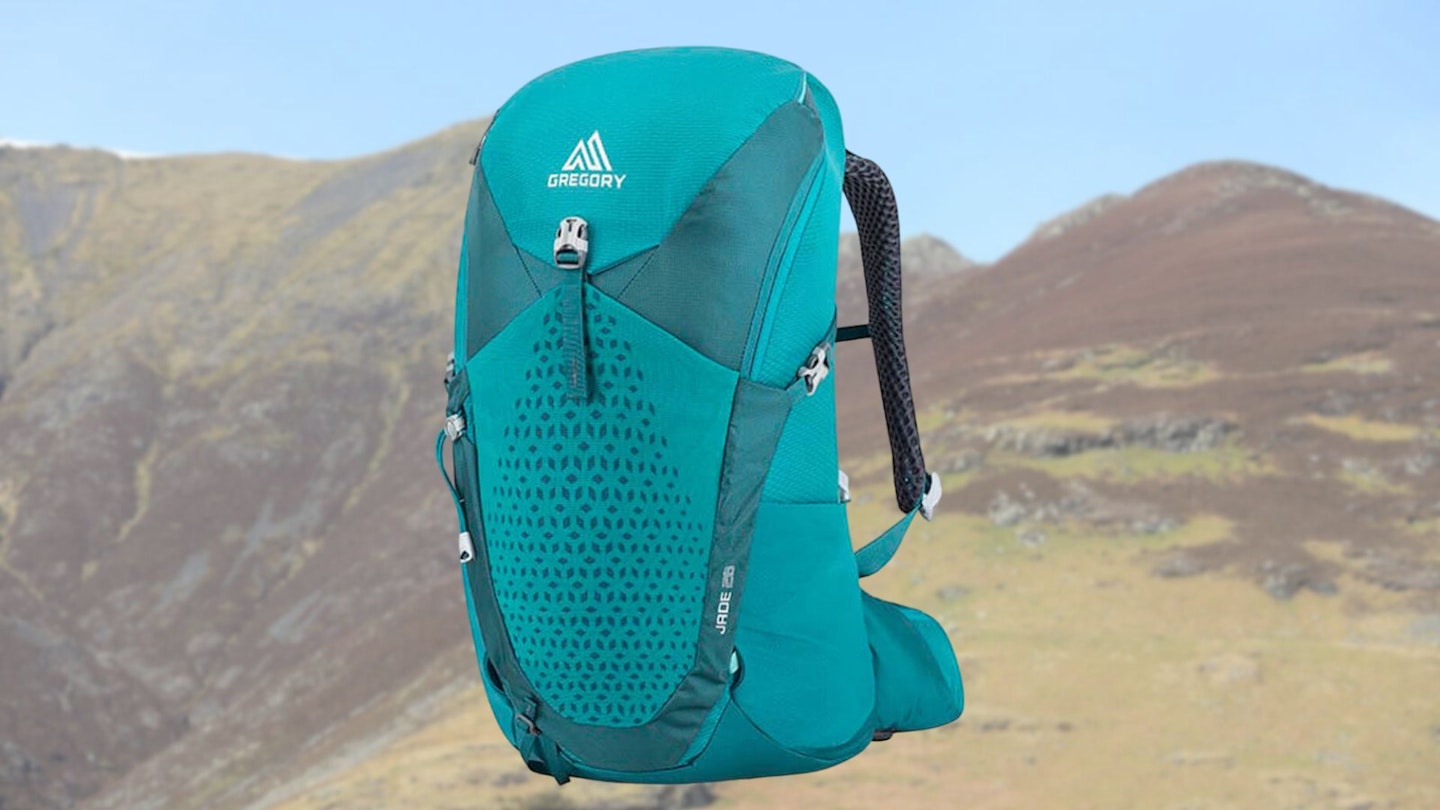Choosing the right backpack is an important decision when it comes to maximising the quality of your time outside. But the best backpacks for women can be difficult to find: determining what fits and what doesn’t depends on a whole range of factors including the unique requirements of your own body type, and what you’ll actually be using the bag for.
It’s one of those no-one-size-fits-all scenarios, but there are definitely certain things you should consider if you’re a lass looking for the perfect pack.
Women's backpacks usually have a shorter back length, better padding on the hips and sternum straps, and tend to be smaller in volume than the male equivalent (for better or worse). Often a model will come in both a men’s and a women’s fit, so do try both on if you get the chance and see if you can tell the difference.
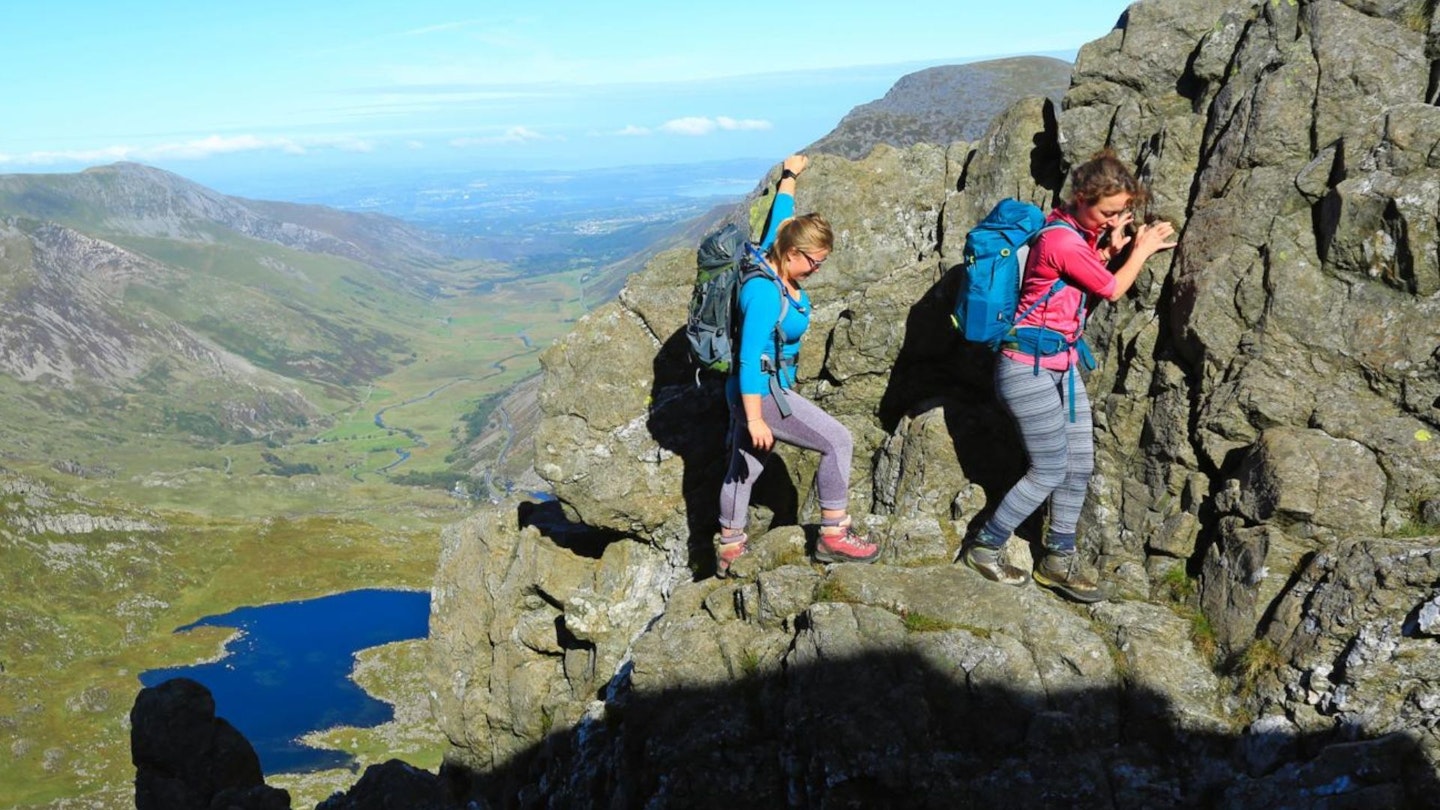
What are the best women's backpacks of 2025?
As a rule, the more you’re carrying and the longer you’re carrying it for, the better you’ll want your bag to fit. For example, it might not matter too much if your daily commuting bag isn’t specific but it’ll suddenly matter a whole lot more if you’re doing the West Highland Way with a 60L bag which hangs off you in all the wrong places.
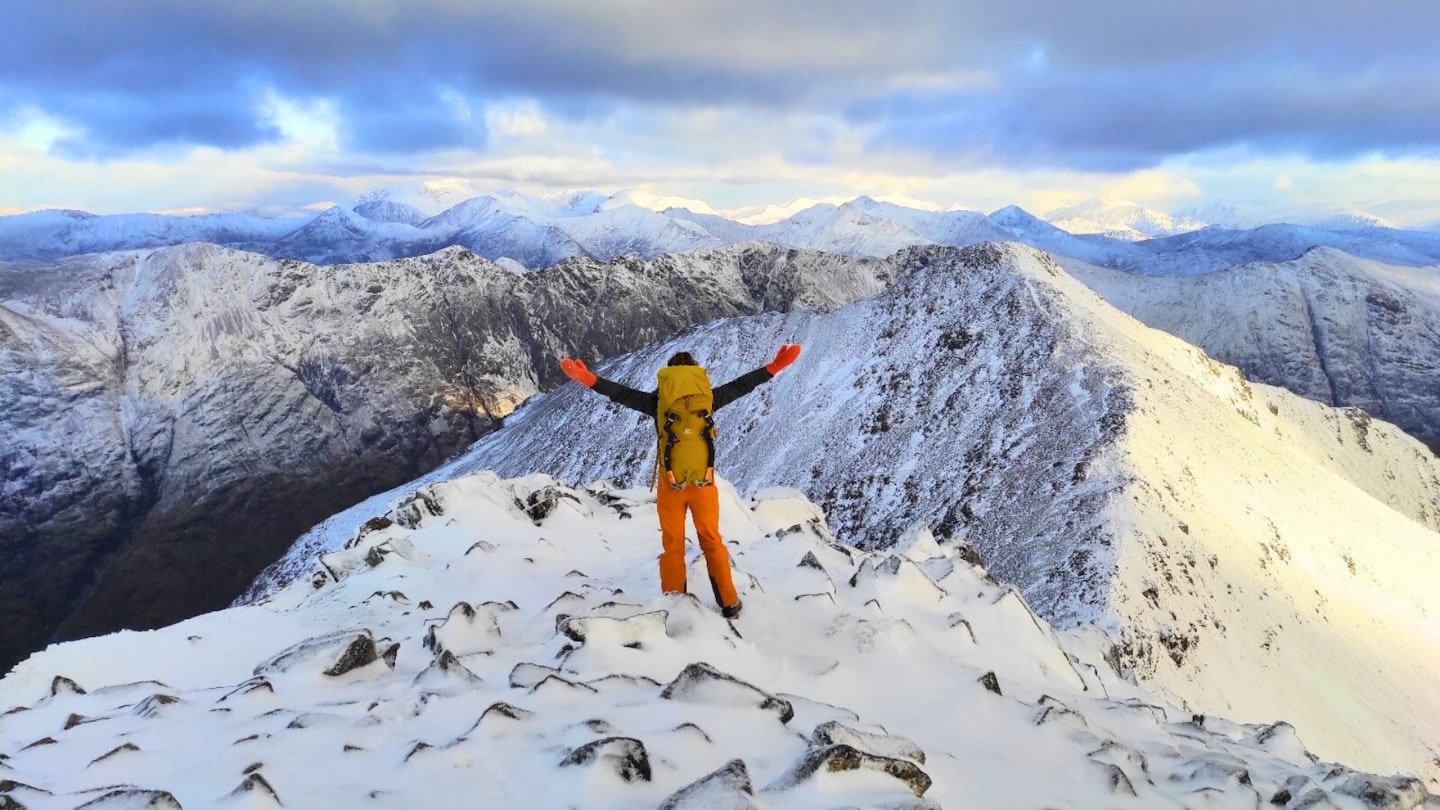
Happily however, our network of female gear testers at LFTO have got some great recommendations for the best backpacks for women. From daypacks to mountaineering packs, to larger hiking bags and travel packs, we’ve been testing the best female-specific backpacks for years.
We’ve included our top picks here, alongside two or three unisex bags that have shorter back lengths, which also fit us really well.
How we tested the best women's backpacks
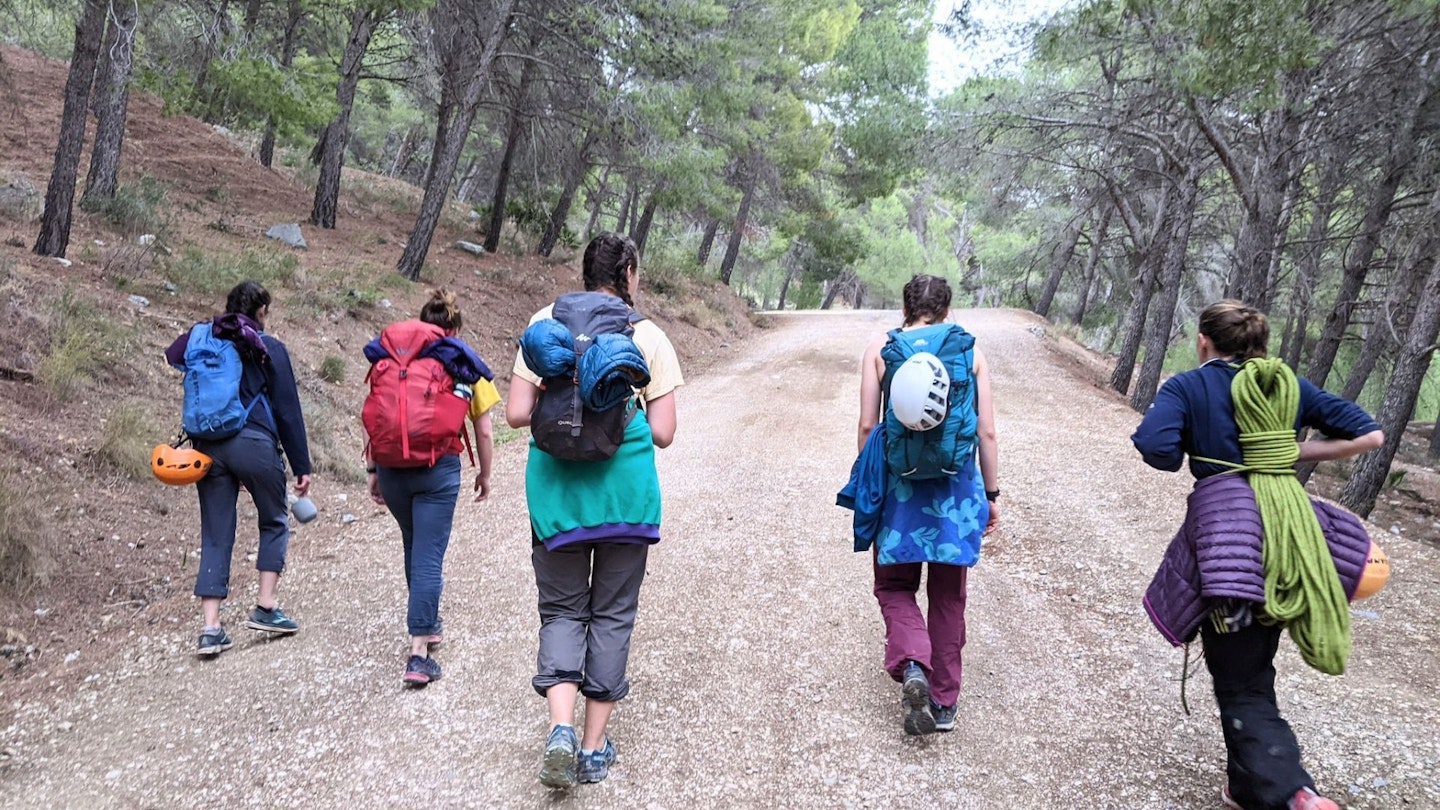
These backpacks have been tested and reviewed by female freelance testers and staff writers - and friends - of the Trail, LFTO and Country Walking teams: Fliss Freeborn, Sarah Ryan, Lauren Baker and Jenna Maryniak.
Best women's backpacks reviewed:
The Tempest is one of the biggest selling daypacks in the world. Or, to put it another way, we’ve never climbed Snowdon and not seen someone carrying one. What’s its secret? Well, it just has everything: copious main space, well thought-out alternative storage, huge hip-fins with big, easy-access pockets, clever ‘stow- on-the-go’ attachments for your walking poles, space for a hydration bladder and a breezy back system whose length is highly customisable.
(A word on Osprey’s back systems: this one sits close to your back; if you want a suspended system, Osprey offers the Stratos/Sirrus range, but we find that the Tempest's works great even in midsummer anyway.)
The zip pulls are user-friendly, the chest strap is on a slider and the harness is well-ventilated. And as a whole, it comes as close as any pack to being undetectable when worn. It’s slightly fussier than the Gregory Jade, there’s no raincover and personally we don’t need the chunky cycling/climbing helmet attachments But these are small quibbles. There’s a reason it sells like hot cakes: it’s really, really good.
Pros
- Fantastic all-rounder
- Outstanding comfort
- Customisable back length
Cons
- No raincover
| Weight | 1.07kg |
| Volumes | 7L, 18L, 22L, 28L, 32L, 38L, 48L |
| Materials | Bluesign-approved recycled 100D x 210D and 420HD nylon w/ PFC-free DWR |
| Max weight capacity | 8kg |
This has the capacity and features for a long day’s hiking, and Berghaus have carefully thought through every detail, from access to the main compartment, to the size and positioning of its many pockets. This is a maximalist pack, and at over a kilo, it's not one of the lighter hiking bags on test - but we love it for its excellent all-round hill versatility.
The specific female fit back system is fully adjustable, with hook and loop to hold it securely in place and deliver a stable, comfortable carry. The back system itself is centred around a supportive foam backboard with a mesh carry system with a pocket for airflow, keeping you cooler on the uphills. On that note, however, this is a backpack designed for cooler climes. The substantial padding on the hip belt, which cradles the body oh-so-snugly, quickly becomes sweaty when the mercury reaches above 25 degrees on a regular basis.
However, for the UK and northern Europe, the Remote Hike 35 is fab. We particularly like the easy-grab pocket for things like maps, snacks and waterproofs, should you be caught out in showery weather and be taking things on and off constantly.
Pros
- Great value
- Very comfortable and supportive carry
- Good features
Cons
- Not ideal for hot weather
- Not the lightest bag on test
| Weight | 1.02kg |
| Volumes | 35L |
| Materials | 300D high density polyester and 100D nylon |
| Max weight capacity | Not stated |
A favourite of dirtbag climbers, the Simond Alpinism 33 offers absolutely everything you could need or want from a mountaineering pack, at a bafflingly good price. Perhaps the handiest feature is that there's a bottom zip entry, meaning that you're not scrabbling around for your rack or snacks when you need them. The 33L capacity is more than enough when you consider that you've got a separate carrying system for your helmet, which we've found also double up as a good stash pocket for waterproofs if you're using the bag for hiking rather than climbing or skiing.
We also love that you can choose the level of back support you want: remove the foam for a fast and light pack which will compress down into a larger expedition duffel bag, or keep it in for a more comfortable and supportive carry for a big day (or two, with a bivvy in between).
Of course, what really sets this pack apart from the rest is the ludicrous price. At under £60, sure, it's not going to be the best mountaineering bag you've ever used, but it performs like something that could easily cost twice as much. Durability, which we'd have assumed would be the first thing to disappear as the price-point shrinks, doesn't seem to be much of an issue: it's surprisingly tough, with Ripstop 420 denier polyamide as the main fabric, which has thus far proved incredibly durable, even when being dragged over sharp granite in the alps. If you're getting into scrambling or climbing, then this is the perfect first bag for you - but even if you're just a hiker it's pretty great value too.
Pros
- Outstanding value
- Great durability
- Useful side pocket
Cons
- Back can get a little sweaty on longer hikes
| Weight | 990g |
| Volumes | 33L |
| Materials | Ripstop 420D polyamide main fabric, 1600D polyester bag bottom |
| Max weight capacity | Not stated |
Mammut often market their gear for mountaineering, but the Ducan is aimed at women who hike. In fact they’ve designed it specifically for the shape of the female body, and when first trying it on, it instantly felt really snug from shoulders to hips. The ventilation is excellent – the mesh maintains a constant airflow on our backs.
One thing we particularly love is the bungee- cord chest strap, which helps keep the pack secure, while also allowing full movement when I need to take deep breaths. We also like the phone holder on the hip belt – the phone sits vertically in a pocket that hangs down from the belt, and there’s room for other small knick-knacks in a separate compartment.
We also found we can pack an extraordinary amount into the main pocket, given that it’s just 24 litres - and we can squeeze quite a bit more into the lid pockets too. The bag also holds its shape thanks to its sturdy frame. It’s generally a really comfortable rucksack, but we do find, when getting into our stride, that the hip belt rises slightly, and we have to pull it down again. Overall, though, this is an excellent bag.
Pros
- Great female fit
- Very spacious
- Great features
Cons
- Hip belt has a tendency to rise up
| Weight | 920g |
| Volumes | 24L, 30L |
| Materials | 91% polyamide, 9% polyester w/ PFC-free DWR |
| Max weight capacity | Not stated |
This is the return of an old design but you wouldn’t guess that, so complete is the upgrade. The new Freeflow range is unisex, but the ‘S’ versions have shorter back lengths which are likely to fit women better. The old Freeflow was an affordable workhorse; this has a more advanced design and higher price point to match. The whole package is sleek and futuristic. The back system is a continuous sheet of mesh tensioned across a concave frame. This means that the pressure of the load tends to focus on the lower back, but the bag is cushioned here with lumbar padding.
We found that it really did prevent our backs from getting too sweaty, even on a consistent uphill climb. We're also a big fan of the pockets, especially those on the shoulder straps, and the drawcord adjustable side pockets – it makes getting a bottle in or out much easier. The body of the pack has a kind of clamshell design, with the zip running all around the top half, making it easy to find things. Our only gripe is that the tensioning cords down the sides tend to get in the way of the zip. All in all, though, We're very impressed.
Read our full Berghaus Freeflow 24 review
Pros
- Fantastic ventilation
- Adjustable side pockets
- Useful clamshell design
Cons
- Tensioning cords can obstruct zip
| Weight | 1280g |
| Volumes | 24L, 30L, 30+5L |
| Materials | 100% recycled 210D nylon w/ PFC-free PU coating |
| Max weight capacity | Not stated |
Any extraneous details are trimmed off this one to create a functional, streamlined pack that is, happily,
also very comfortable to wear. We were sceptical at first, noting the absence of a cord to secure walking poles and only three pockets, but we’ve been won over. We're fans of the single buckle closure which minimises faffing; ditto the side access zip which allows you to quickly and easily access kit at all levels of the bag. Features are extremely minimal, but it works.
Poles are secured with the tensioning straps and loops at the base; pockets are simply done away with. Even the central part of the shoulder straps and hip belt has been cut away. This results in greater flexibility for a close fit as well as allowing ventilation and saving weight. We found it very comfortable and though back systems like this (a lightly padded suspended frame holding the bulk of the pack away from the body) can feel unstable on other packs, it doesn’t here. The fit was so neat and secure that I thought nothing of wearing it for a full, long day in the hills – and have happily done so several times since.
Read our full Salewa Alp Mate pack review
Pros
- Lightweight, minimalist design
- Great ventilation
- Neat fit
Cons
- On the pricey side for a small pack
| Weight | 890 g |
| Volumes | 24L, 30L |
| Materials | 150D polyester, 100D nylon honeycomb |
| Max weight capacity | Not stated |
This is another of the unisex bags which are small and nimble enough to make a fantastic women's hiking pack. Blue Ice is primarily a mountaineering brand, specialising in lightweight climbing and skiing rucksacks, but we've found that their bags perform brilliantly for hill days too.
The 18 litre capacity of the Dragonfly isn't massive, but we've been using it for shorter days out over the last two years, and it's never let us down. A minimalist pack at heart, with one main bag cavity, a simple drawstring catch, mesh drinks bottle pocket and a small zipped valuables pocket, the dragonfly is perfect for fastpacking adventures, or day-hikes where your objective is to do as much in as short a space of time as possible. The bag weighs around 400g, but is supremely comfortable for the weight, with a well-padded shoulder system and a static back mesh to provide breathability for sweatier uphills.
The fit is snug to the shoulders, and while the waist-belt is minimal, the small pack size means you'll not need quite the amount of support you would from other, larger packs with a higher load capacity.
Pros
- Very lightweight
- Comfortable
- Sleek and streamlined
Cons
- Minimalist design won't suit everyone
| Weight | 415g (325g stripped) |
| Volumes | 18L, 26L, 34L |
| Materials | Bluesign-approved, PFC-free 210D nylon |
| Max weight capacity | Not stated |
Deuter have two main lines of hiking day pack – the Futura and the Trail. One of the key differences is the back system, where the Futura has a mesh suspension and the Trail has foam bars – less ventilated perhaps, but it allows more room in the main compartment and keeps the load closer to your back, which you might prefer on tougher terrain.
The foam bars on this new version of the Trail are firm enough, and protrude enough to still ensure good channels of ventilation. The shoulder straps and hip fins are also well padded, but perforated, also helping to keep you cool.
We find it really comfy to wear – it sits nicely on the hips, and the strong frame keeps it in shape. The main pocket offers plenty of room and the U-shaped opening allows you to open the pack like a suitcase and reach all your gear.
The stretchy side pocket offers decent space for a bottle, but the zipped pocket at the other side isn’t so spacious. Nor is the pocket that hangs from the hip belt – it fits a smartphone, just. But these are minor quibbles about an extremely comfy and beautifully made backpack.
Pros
- Comfortable carry
- Really well made
- Good ventilation
Cons
- Not the most spacious pockets
| Weight | 1.43kg |
| Volumes | 28L, 31L, 34L |
| Materials | Recycled and PFC-free 600D polyester and 210D nylon |
| Max weight capacity | Not stated |
With a women's tailored back length, and superb load transfer, the Women's Mammut Trion 38 is an understated hero in the world of mountaineering backpacks. It offers the sleek, minimalist design of many climbing packs, but with more of a squat carry than many others on the market, which tend to rise upwards in a continuous long column.
This makes the Mammut Trion ideal for multi-activity purposes: cycling, skiing and scrambling with a bag that doesn't block upwards head movement is a blessing when you've been suffering as a shorter woman with longer packs. We also love the women-specific shoulder straps and hip belt; the Trion is our top pick for comfort in this category.
Mammut aren't such a common brand in the UK, but are known across Europe for strong, durable kit, (which doesn't often come cheap). The women's Trion retails at £145, which isn't the bargain you'll find with the Decathlon packs but is guaranteed to last - and perform at the highest of mountaineering standards.
Pros
- Squatter design means no impact on head-movement
- Female form is perfectly catered for
- Incredibly durable
Cons
- Not stocked in common UK retailers
| Weight | 960g |
| Volumes | 38L |
| Materials | PFC-free 100D and 210D nylon |
| Max weight capacity | Not stated |
10.
Ortovox Trad 33S
The Ortovox 33S cuts a sleek physique - it's designed primarily with climbing in mind, so its body-hugging shape stays close to your back as to not mess up your centre of gravity too much. We have used this bag for climbing, mountaineering, and skiing, but be warmed that if you're looking for a hiking back that'll do the odd scramble, you're better off with a different brand. The Ortovox is a true climber's pack and the snug back system that's so useful for vertical ascending doesn't do quite as well on the old ventilation front for long days hiking.
But if you're a keen mountaineer, then keep reading. The Ortovox isn't super-duper lightweight as it is - a little over 1kg for a 33L pack is about average - but there is option to remove the aluminium frame if you're on the gram-shedding bandwagon. What the Ortovox is, however, is durable. In fact, the entire thing has been designed with quality and toughness in mind, with 420 ripstop fabric throughout.
Happily, the Ortovox scores very highly on sustainability too - it contains no environmentally harmful per- or polyfluorinated chemicals (PFCs), was manufactured under fair working conditions in conformity with Fair Wear Foundation, contains recycled materials and Ortovox also offset their carbon emissions.
We really like the fact that it's been designed with the female mountaineer in mind: the back length is shorter than Ortovox's regular back system packs; the shoulder straps are thinner and shorter, and they have a pronounced S shape that is most suited to the female anatomy.
Pros
- Slim design
- Durable
- Good female fit
Cons
- Not great on back ventilation for big hiking days
| Weight | 1.06kg |
| Volumes | 26L, 33L |
| Materials | Majority recycled 420D nylon w/ PFC-free DWR |
| Max weight capacity | Not stated |
This is an incredibly lightweight bag for its capacity - it's just 924g for the S/XS version, which is about half the weight of many other bags of this size. And Osprey, being Osprey, haven't skimped on quality either: despite being super lightweight, the Eja Pro 55 is comfortable, durable and quite possibly the top-performing bag we've ever tested when it comes to through-hiking.
Osprey's packs can often stray into the 'over-featured' end of the category, with so many bells and whistles you don't know what to do with half of them. Happily, the Eja pro is ultra-lightweight, so it does away with most of them, leaving only the essentials: huge side pockets, a series of outer lash-points for tents and roll-mats, capacious hip belt pockets, and a removable lid, to shed even more weight if needs be.
We absolutely love Osprey's airflow system, which means even when the pack is fully loaded and you're working hard uphill, you're kept cool by the mesh suspension - which also makes the bag feel like featherlight your back. Does all this come at a cost? Absolutely it does. At around £240, this is at the top end of any budget, so bear in mind how often you'll be using it. If you're about to do a long distance hiking trail, or are a regular trail aficionado, it'll be worth its weight in gold. But if you're only using it for the occasional weekend camp, then something this high-end might not be worth the initial outlay.
Pros
- Incredibly lightweight
- Great features
- Good female fit
Cons
- Expensive
| Weight | 924g |
| Volumes | 55L |
| Materials | 100D x 200D nylon w/ PFC-free DWR |
| Max weight capacity | 18kg |
12.
Gregory Maven 55
Sometimes, all you want is a something nice and simple: not too fancy, not too stodgy. The Gregory Maven 55 is the fish-finger sandwich to the delicate champagne jelly of the Osprey Eja Pro. It's a comfortable, durable workhorse which is a fantastic all rounder in the outdoors, and at 200g lighter than the Lowe Alpine Sirac (let's call that one pie and mash), it's a breeze to carry.
With a larger load capacity of 23kg, the Maven ticks all the boxes for a through-hiking pack for longer trips. Our favourite feature is the side zip, which allows easy access into the bag's interior without rummaging around in the rain like some sort of outdoorsy racoon. We also like the stash pocket on the front for easy waterproof or windproof storage - but again, we're not huge on the dual-entry mesh side pockets which are only really suitable for waterbottles (like the Sirac 50, anything smaller just falls out the moment you bend over).
Overall, thought, this is a great bit of kit. It's not the cheapest sack on the street, but the high density nylon will last for years and the carry is more comfortable than most of the bargain bags out there.
Pros
- Great all-rounder
- High quality materials and design
- Large load capacity
Cons
- Dual entry side pockets are for larger items only
| Weight | 1.55kg |
| Volumes | 55L |
| Materials | 100D and 210D nylon |
| Max weight capacity | 23kg |
The Lowe Alpine Sirac series consists of a brilliantly sturdy set of packs - a 40, 50, and 65 litre - all available in a female-specific fit. We've had our paws all over the Sirac 50 since it came out, and it really does do everything you want in a trekking pack: it's spacious enough for a week's worth of camping and walking gear; it's a supremely comfortable carry; and it's not as over-featured as many larger hiking packs can be, meaning you don't lose your stuff down various pockets for years on end.
The one drawback of the backpack is the duel-entrance side pockets. Unless you're carrying a waterbottle, or stuffing something bigger and bulkier like a waterproof jacket down them, then smaller stuff is prone to falling out of the pockets due to them only being sewn up on two of the four sides. It's a minor niggle, however, and the value, space and comfort of the sirac more than makes up for only being able to store smaller stuff in the lid or the hip belt pockets.
Overall, the sirac is a great choice for a trekking bag - and at £60 cheaper than the Osprey Eja Pro, it's really good value in the field.
Pros
- Sturdy
- Spacious
- Comfortable carry
Cons
- Slightly heavier than other packs of similar size
| Weight | 1.77kg |
| Volumes | 40L, 50L, 65L |
| Materials | 50% recycled 420D Dobby and 100% recycled 600D PW w/ HydroShield |
| Max weight capacity | Not stated |
The Women's Travel 900 from Decathlon's Forclaz range is a backpack is a brilliant choice for a take-everything-but-the-kitchen-sink travel backpack.
It’s got a great capacity and compartments, has several handy features like a passport pocket and a spare daypack for travel, is logically designed with function in mind, and most importantly, does not break the bank.
We searched high and low for a larger travel pack that ticked as many boxes as this one, including those in much higher price brackets. But in the end nothing seemed to fit the bill as seamlessly as the Women's Travel 900. And all for £104.99 – easily half what most other packs on the market will set you back.
Read our full Decathlon Forclaz Women's Travel 900 60+6L review
Pros
- True women's fit
- Impressive comfort
- Loads of storage features
- Front suitcase-style opening
- Raincover included
- Great value
Cons
- Tad heavier than some rivals
- No colour options
| Weight | 2.4kg |
| Volumes | 50+6L, 60+6L, 70+6 (men's only) |
| Materials | Polyester w/ PU coating |
| Max Load capacity | Not stated |
Another unisex bag that fits women really well - all too often we find ‘unisex fit’ packs don’t fit our shape brilliantly; they’re often too wide around the shoulders so that they chafe and slide off. But not so here. And we're delighted because we love this ultra-light, lemon-yellow pack.
Just the look of it puts a spring in our step and there’s no bulk to hold us down. If you are on the shorter side, Kathmandu also do a women's specific fit, but we tested the unisex one because it's a much nicer colour!
Part of what contributes to its low weight is a stripping back of features. The waist belt is a simple webbing strap and extra pockets are minimal: there are only the two stretchy side pockets, one security pocket inside the lid and a nifty mesh mobile phone pocket on the shoulder. That means there isn’t much option for overpacking, but that doesn’t matter because this little bag is surprisingly capacious, easily swallowing all the kit needed for a summer hill-walk. And the features it does have, we really like.
The zips have huge loop pulls, making them easy to grab even with gloves or cold, fumbling hands. It also sits close to the body, with just a pitted mesh back system. It suits the pack, with its low weight and stripped-back features, making it perfect for fast-paced or agile days.
Pros
- Great colour
- Light and nimble
- Surprisingly capacious
Cons
- Might be too limited in size for larger people's kit
| Weight | 520g |
| Volumes | 20L, 28L, 38L, 45L, 48L, 55L |
| Materials | Recycled nylo, polyester w/ DWR |
| Max weight capacity | Not stated |
16.
Gregory Jade 28
This pack moulds perfectly to the shape of our back. It’s been designed to fit the curvature of a woman’s spine (especially the base which can otherwise suffer with sturdy but straight packs). It sits comfortably on our hips, and is height adjustable too, so we can get it exactly how we want it. The hip belt feels snug and supportive and the mesh back system works a treat when it comes to maintaining good airflow.
The Jade has an extra large opening at the top, which it calls U-Zip, and this is a great feature for accessing gear more easily. It also has generously sized front, side and hip belt pockets – the side pockets are wide enough to fit more than a drink and the strapping starts inside the pockets, so you can tie down small items as well as large.
But it’s awkward to pack large items into the main pocket when a full hydration system is in place, as it creates a tricky shape. The biggest drawback is the rigid frame at the top of the pack which makes it difficult to look upwards. Adjusting the height helped a bit, but it’s something to check before buying, especially if you're a little smaller.
Pros
- Great female fit
- Good airflow
- Large U-shaped opening
Cons
- Awkward to pack main pocket with full hydration system in place
- Rigid frame can impede head movement for shorter users
| Weight | 1.38kg |
| Volumes | 28L, 38L, 53L |
| Materials | 420d nylon and partially recycled 400D polyester w/ PFC-free DWR |
| Max weight capacity | 18kg |
What to look for in women's backpacks
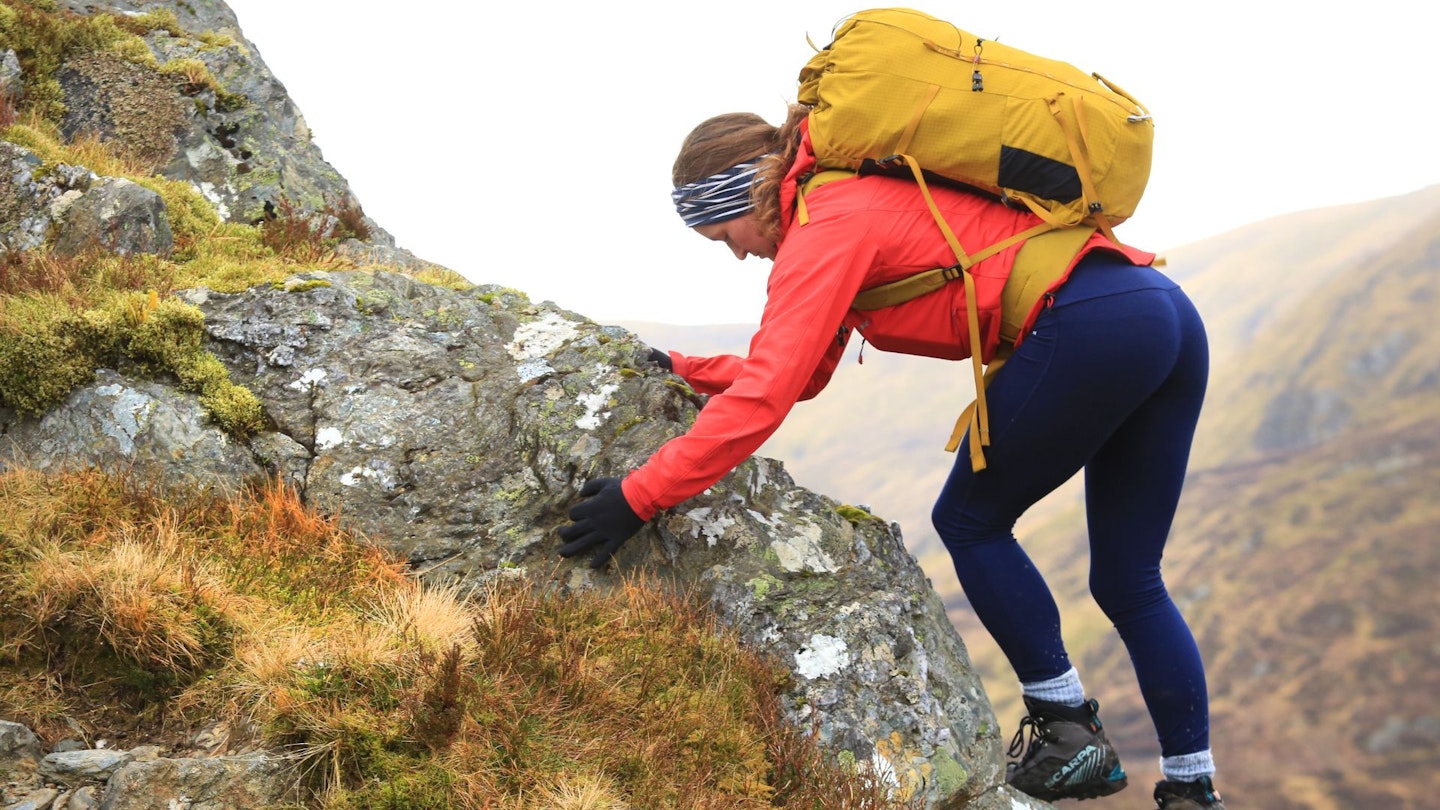
How should a backpack fit a woman?
A female specific backpack should fit in the same way as any other backpack: comfortably. The majority of the weight should be on your hips, with the rest distributed across the chest and the shoulders. Making sure that the sternum strap is at a comfortable height, rather than being too low and digging into your bust is essential.
What makes a backpack a woman's backpack?

For the most part, women's packs are designed with a shorter torso length in mind. Sometimes you get a wee bit more padding on the hips, and a slightly more adjustable sternum strap, but mostly it’s just a few cm shorter in the back. This can have knock-on effects on carrying capacity, but for the most part we've found that women's clothing is smaller, lighter and so the 1-2 litre differences in women's vs other packs isn't quite as noticeable.
Should a backpack be on the hips or waist?
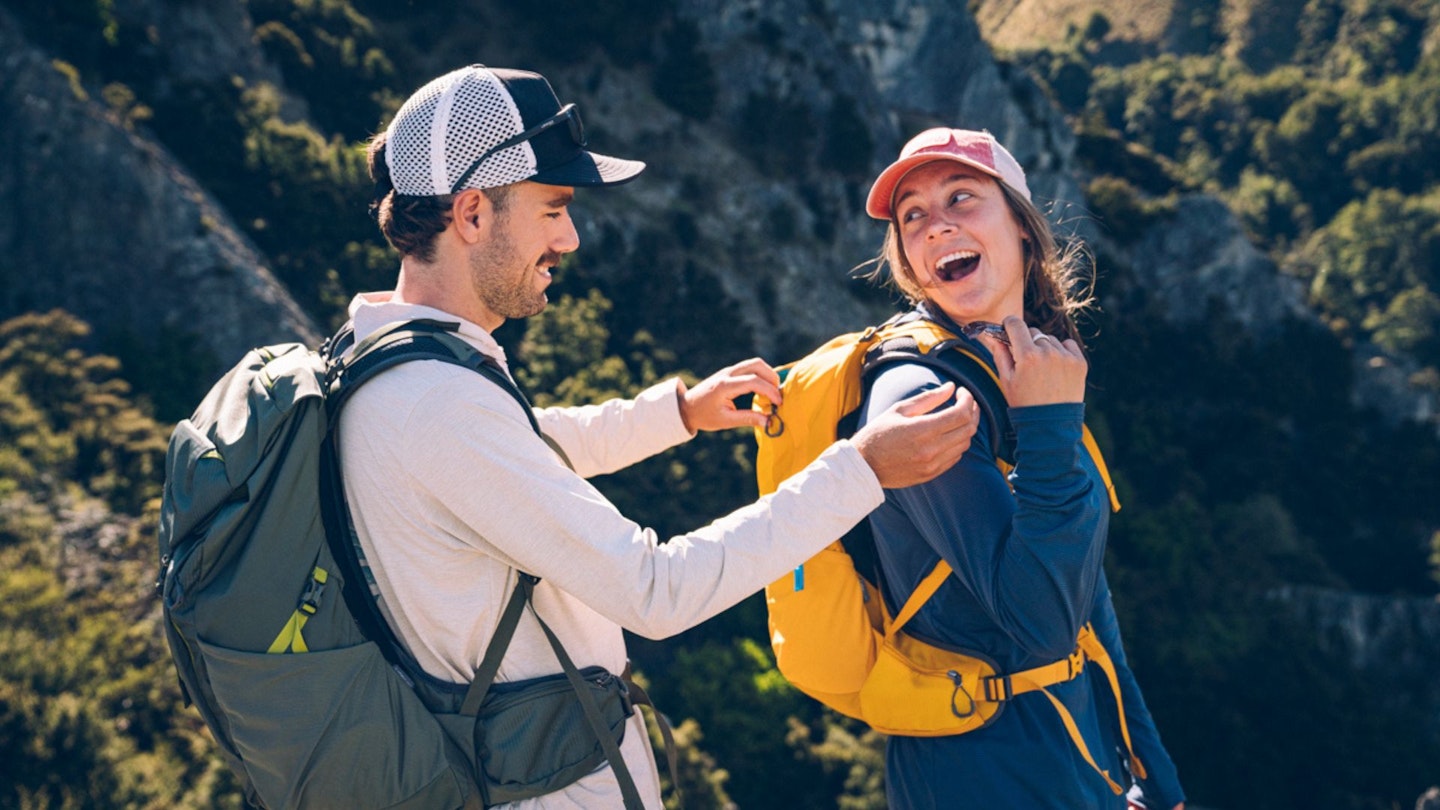
The bag's weight should sit on your hips rather than your waist. If you're constricting either your waist or chest, then you won't be able to breathe properly; your hips are a much better bet for taking the majority of the weight, which is why having a supportive, cushioned hip belt for larger loads is so important.
What should I look for in a women’s backpack?
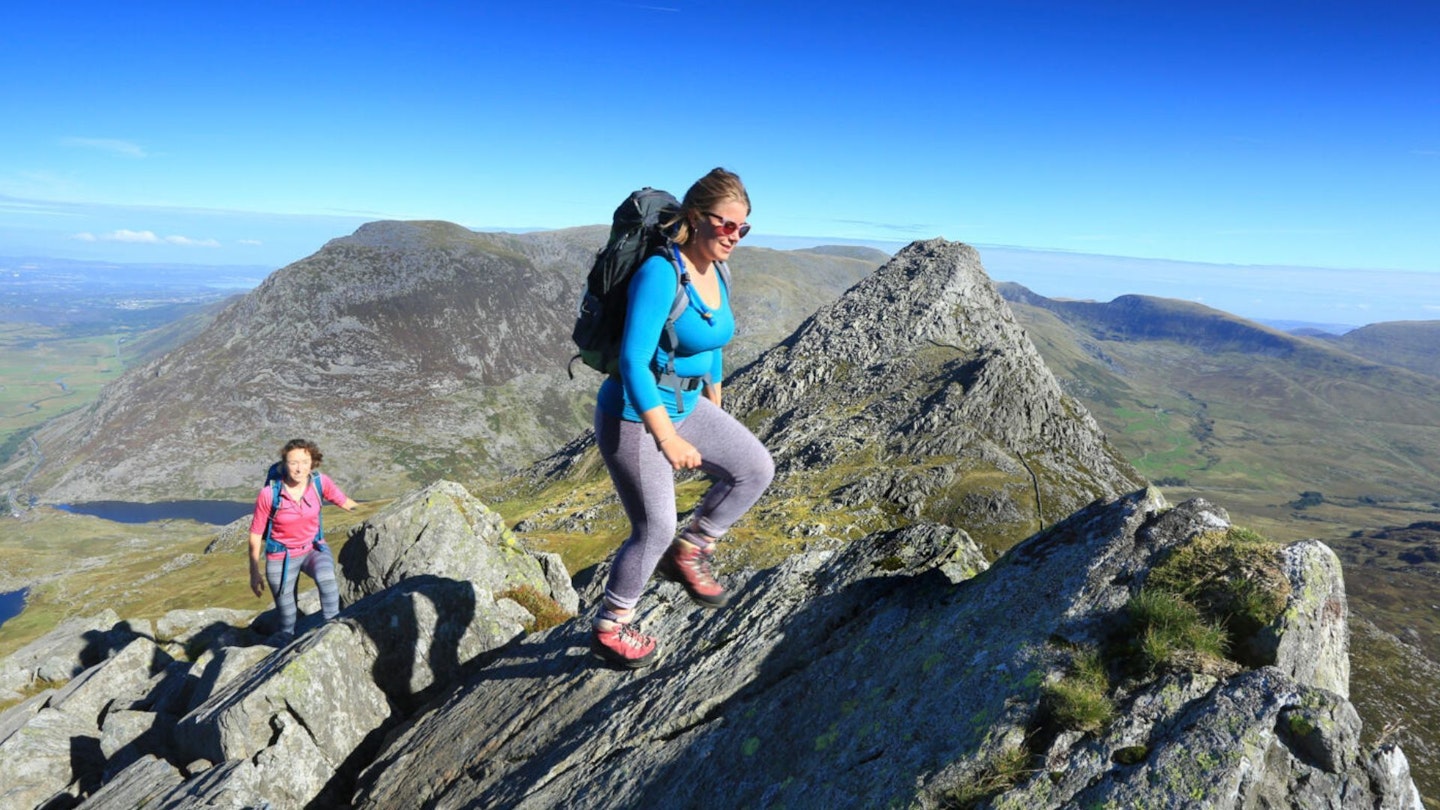
There are many things to look for when investing in an important piece of gear such as a rucksack. Materials, fit, features, sustainability and value are all important considerations - but none are so important as deciding what it actually is you'll be wanting to use your rucksack for, because that'll inform all of those aforementioned qualities.
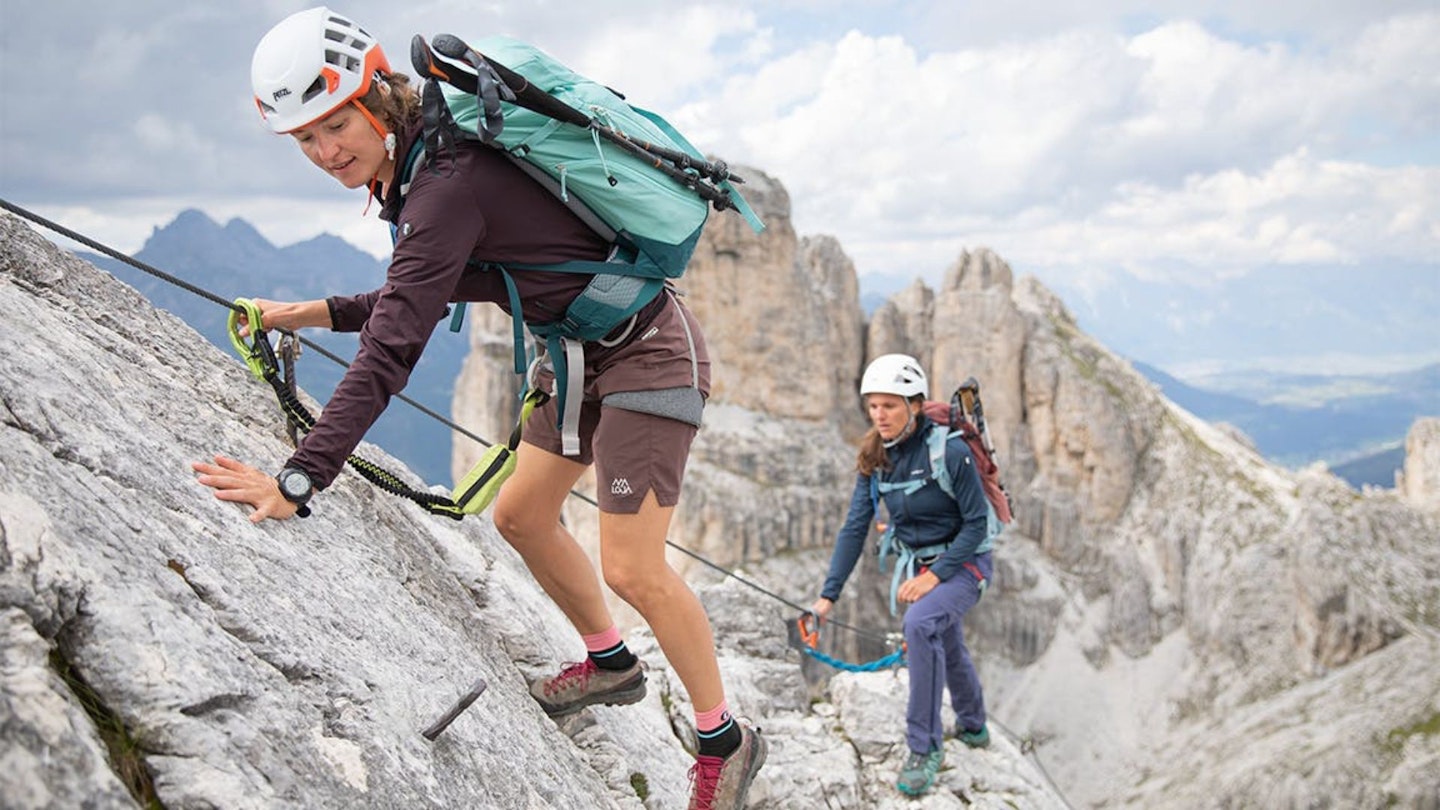
Walking rucksack categories are often split into trekking, backpacking and mountaineering. Trekking daypacks vary in size from around 15-45 litres and are designed for everything from summer hikes to scrambling routes and winter mountain days. Backpacking and expedition bags have a large capacity, plus lots of features to help you carry and access everything you need for multi-day trips. Mountaineering packs tend to be more stripped back in terms of features to keep them light and simple.
Our quick guide to backpack capacity:
Buy too big and you’ll fill it with unnecessary junk. Go too small and you’ll end up leaving stuff behind. Here’s a rough guide to the size you need for specific types of walk:
15-25 Litres: Fast or light hill walk.
25-35 Litres: Hikes in spring, summer or autumn.
35-45 Litres: Longer mountain walks, scrambling and mountaineering.
45-55 Litres: Winter mountains, lightweight wild camps, hut-to-hut trips.
55-75 Litres: Camping expeditions, long-distance trails.
75+ Litres: Epic expeditions only! And avoid completely if you're under 5'5"!

Fit
Once you've established what sort of pack you want, the next thing to think about is how it fits. The most crucial thing to get right when fitting a backpack - and where female and male packs often differ - is torso length. This is particularly individual, as you can be tall with a short torso, or short with a tall torso; measuring it is the only way to find out. On the larger bags, torso length is usually adjustable and should be the thing you start with when it comes to making sure your bag fits properly.
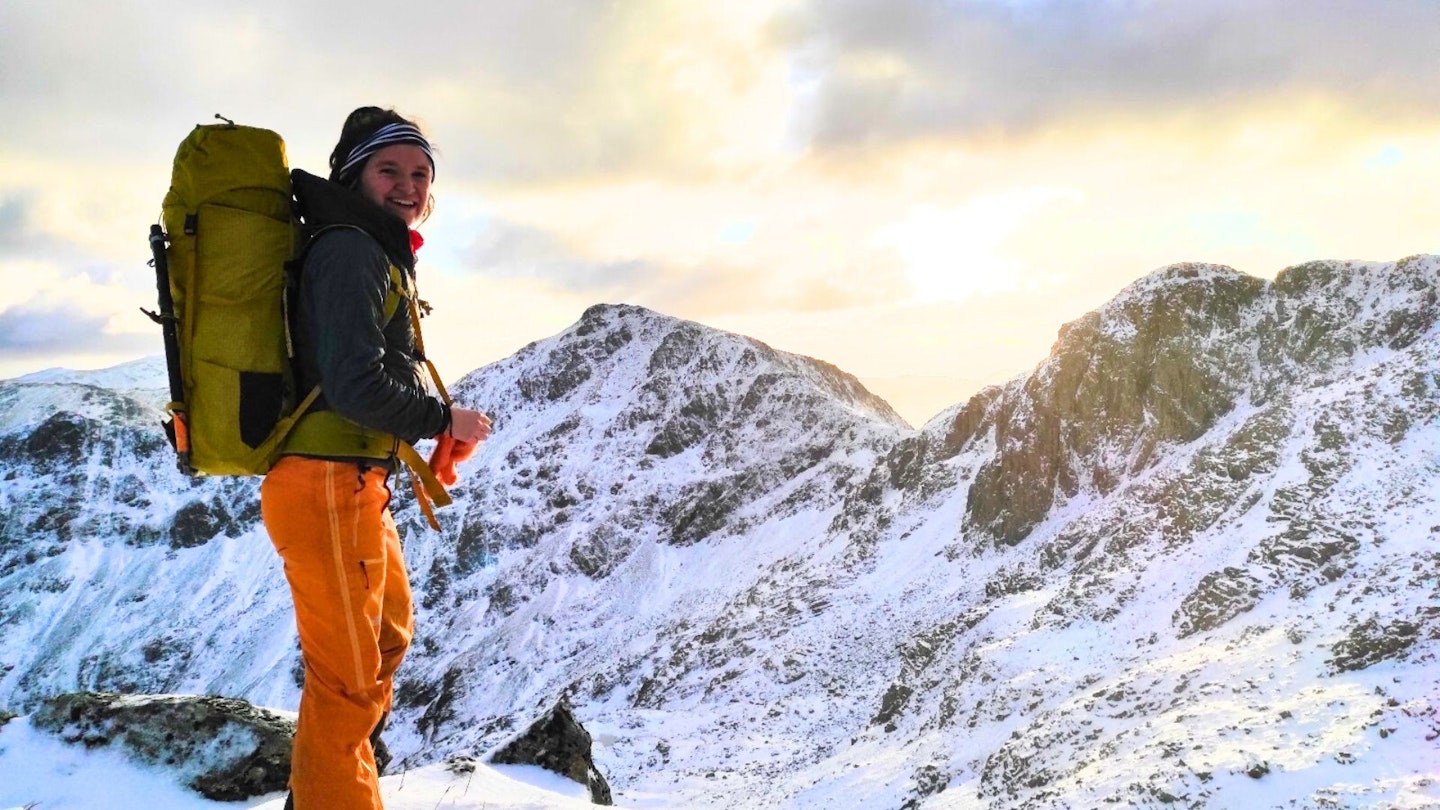
Women with particularly long torsos might find that men’s packs fit better than women’s and any discrepancies in the hip belt placement are usually overridden by finding the correct torso length for you. Similarly, shorter men or men with particularly compact torsos may find that women’s bags fit much better. Getting an expert to help you fit a bag, then adjusting it as you go when you're out and about should enable you to find the best fit for your body.
Back systems
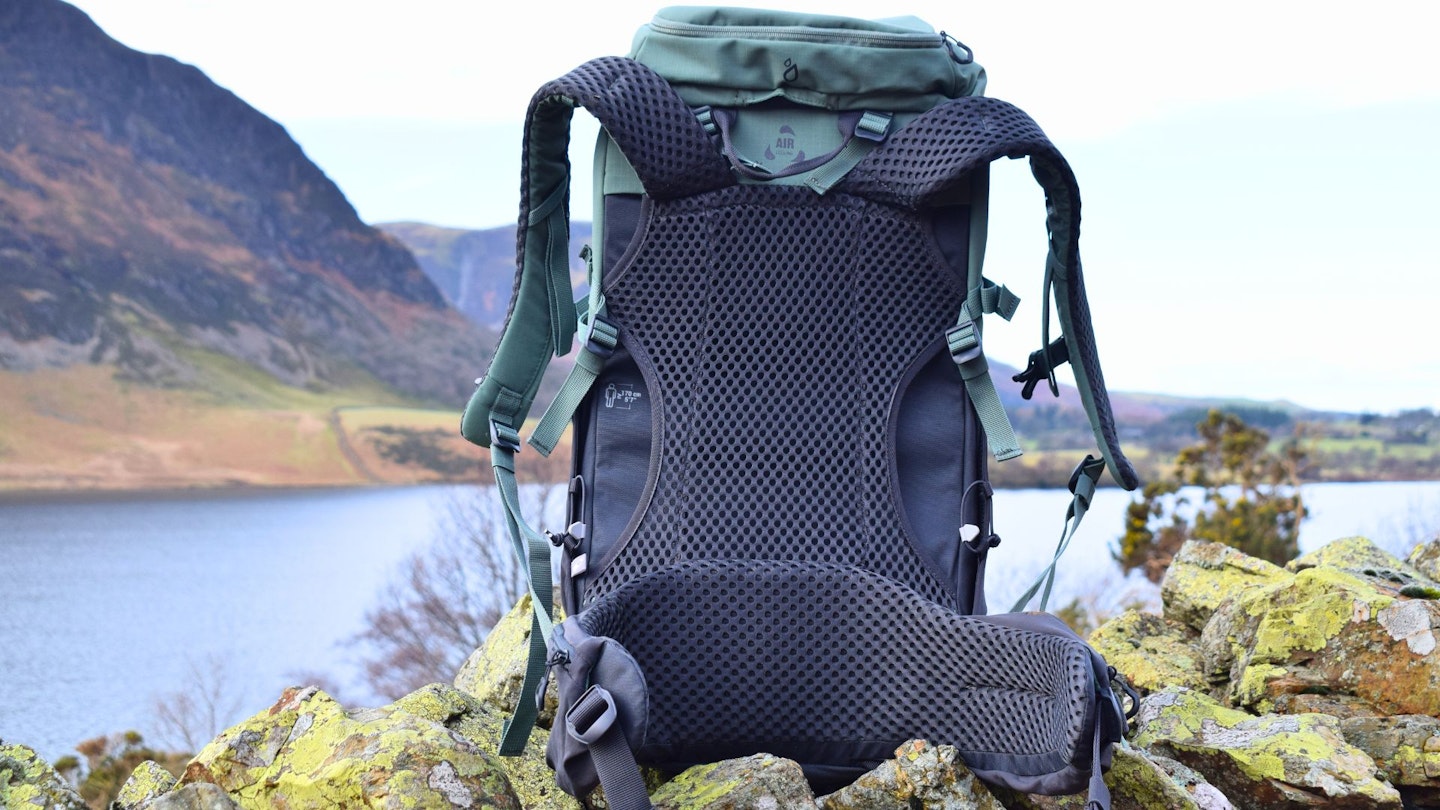
You’ve got a few options with back systems. Either go for a padded foam-type design that fits snugly against your back, a channelled back system that ventilates hot air away from your back, or
a suspended mesh system that lifts the whole bag clean away from your back. This is purely personal choice, so try a few to see what works best for you.
Features
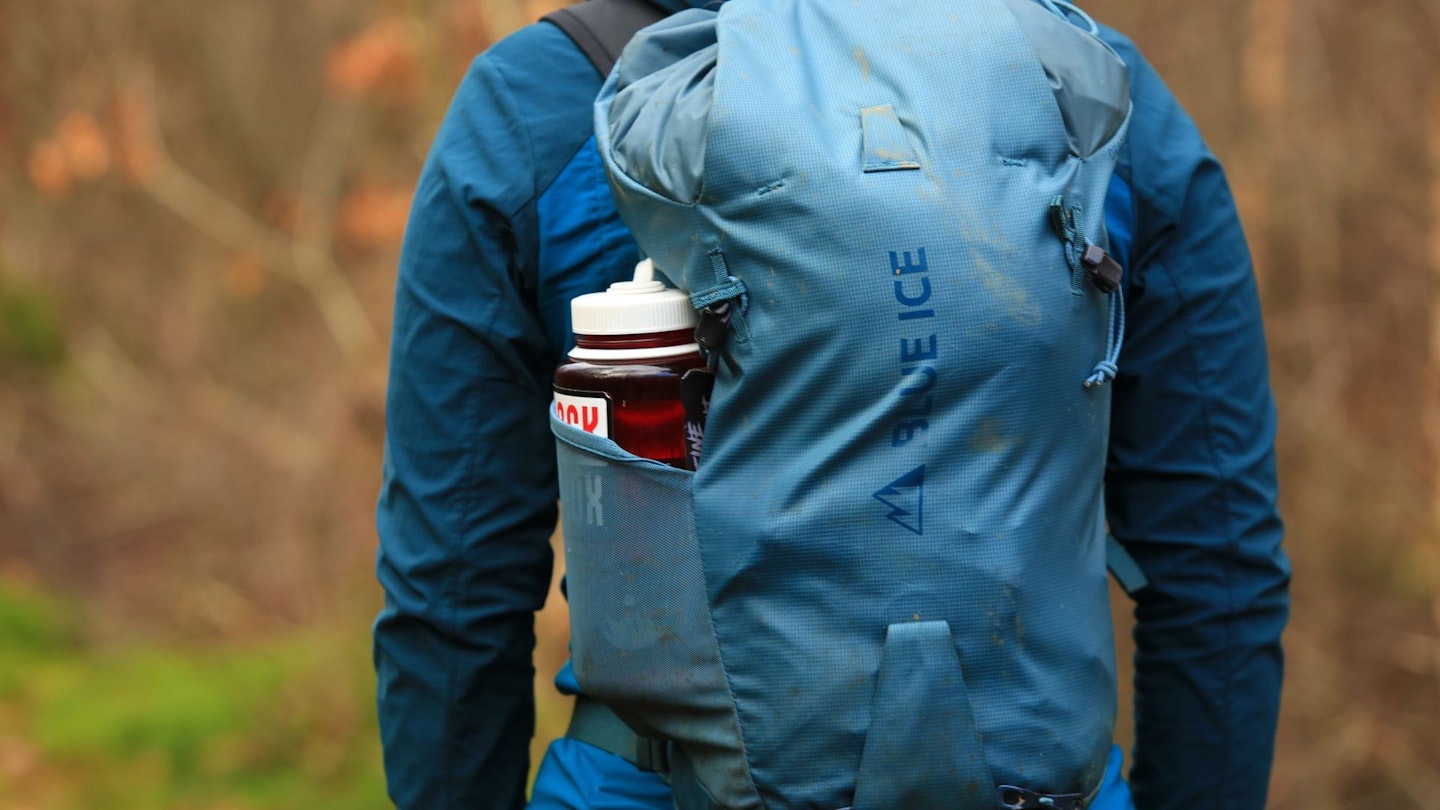
Big side pockets, compression straps, trekking pole loops and ice axe attachments are great if you like stowing gear on the outside of your pack to access in transit. Hipbelt pockets are also useful for stashing things so you can grab them without taking the rucksack off, but check you can actually reach them. Other features to look for include hydration bladder compatibility, a key loop for peace of mind, and internal valuable pockets for things like wallets.
Materials and waterproofing
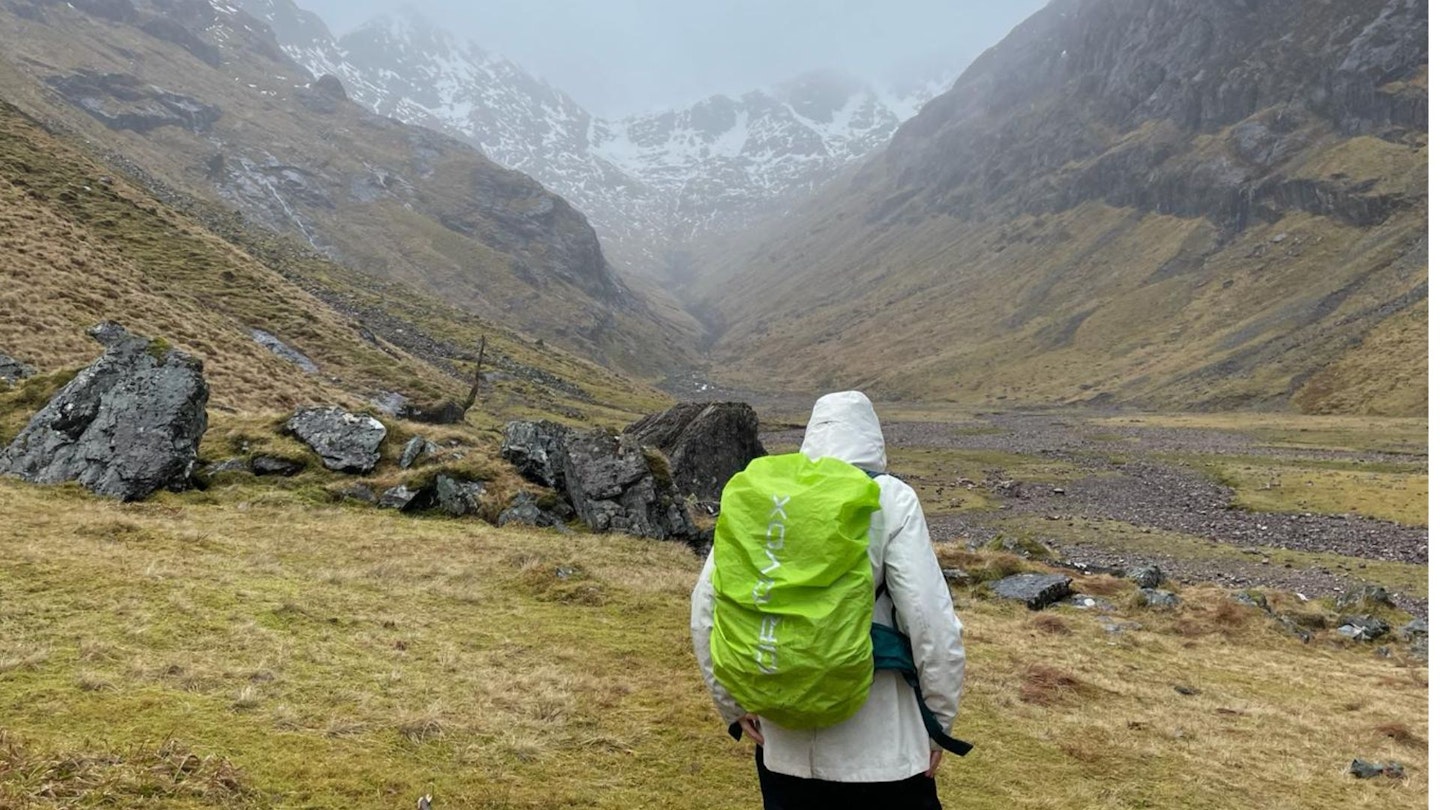
Very few hiking rucksacks are fully waterproof, which means they’ll withstand a bit of rain but when it’s really chucking it down the water will get through. Some packs come with a detachable raincover (often stashed in a small pocket at the base of the pack), but to keep kit completely dry, use good waterproof dry bags inside.
In terms of materials, you'll want something tough and durable, but still lightweight enough to keep you from being weighed down. Ripstop nylon is great, as is 420D nylon, but there are a range of materials out there which each have their own merits.
About the author
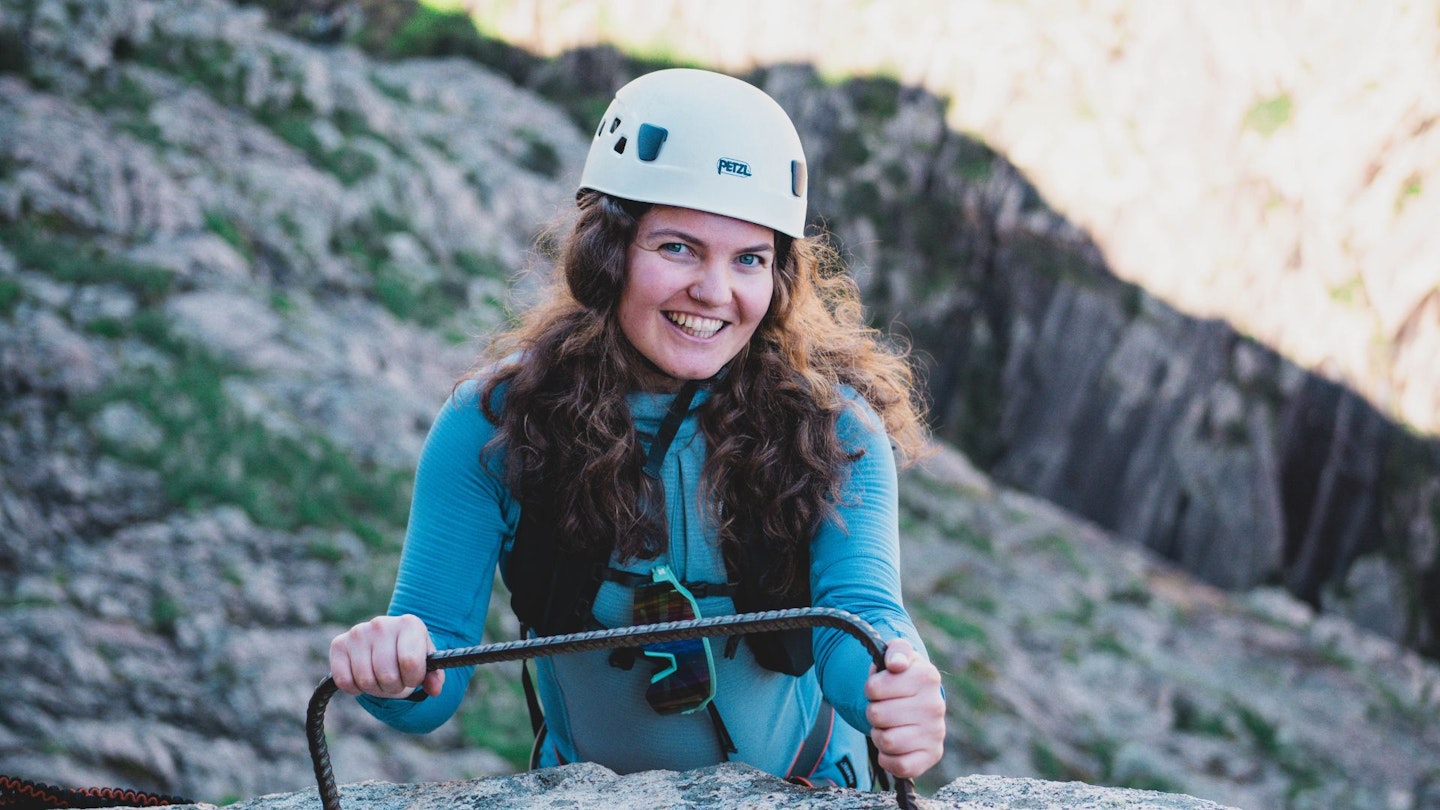
Fliss Freeborn is a writer and gear tester for Live For The Outdoors. During her time at university, she spent considerably more days in a tent in the Scottish Highlands than she did in the library, which she highly recommends as a study strategy.
Fliss also believes that life is too short to eat bad food outdoors, and that cooking good scran while in the hills is easier than you might think with the right kit and some forward planning – yes, you can always do better than a pot noodle.


